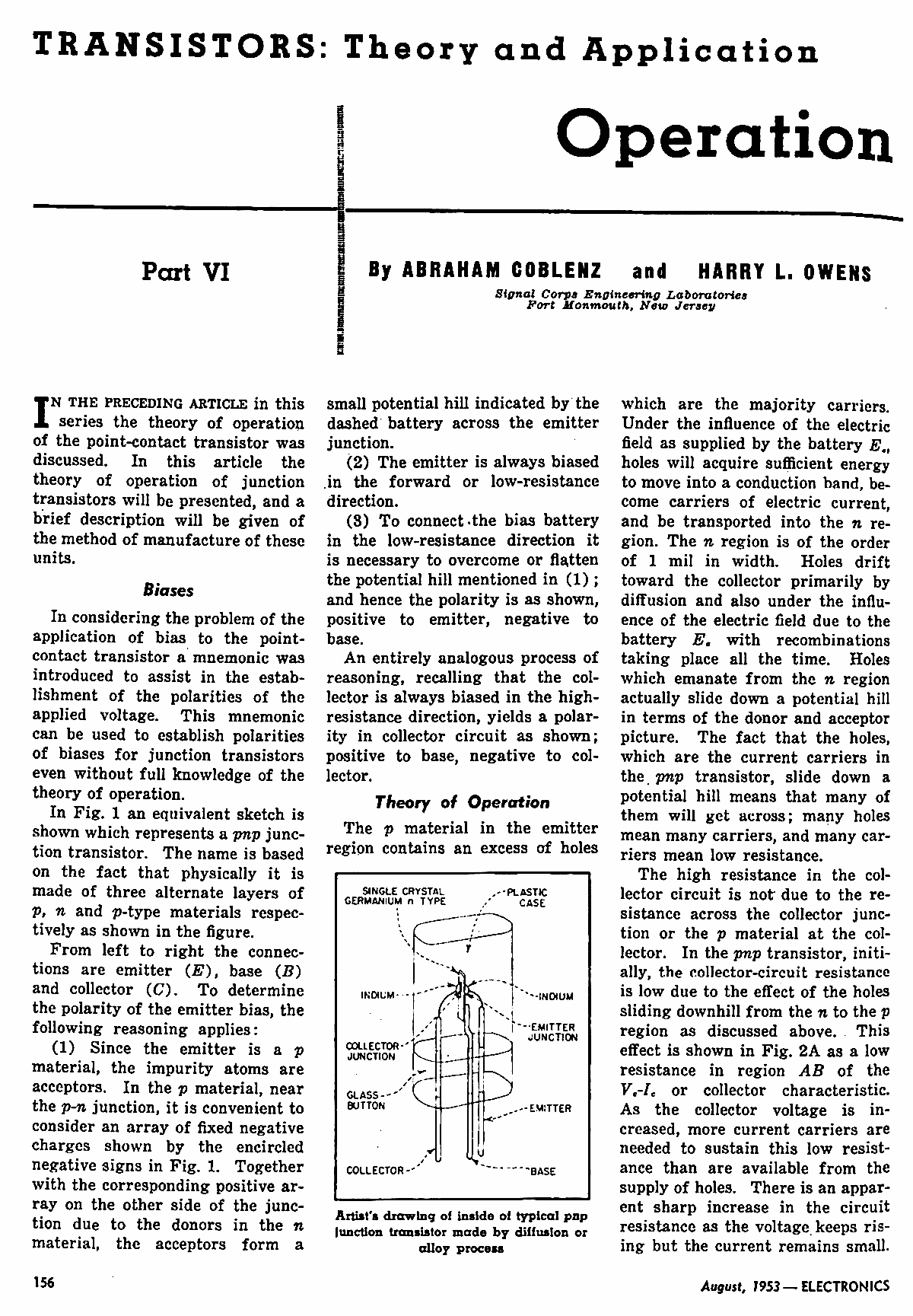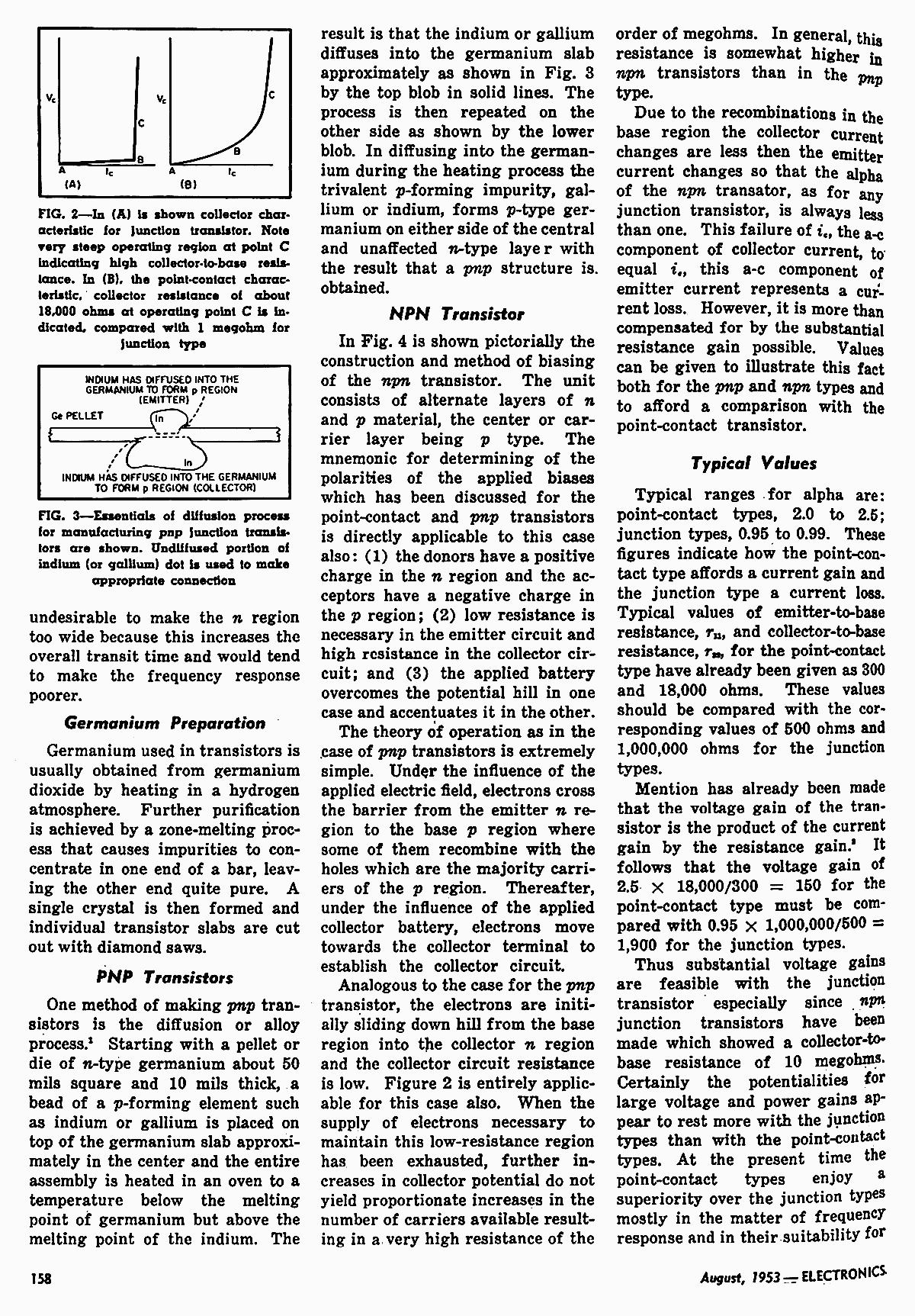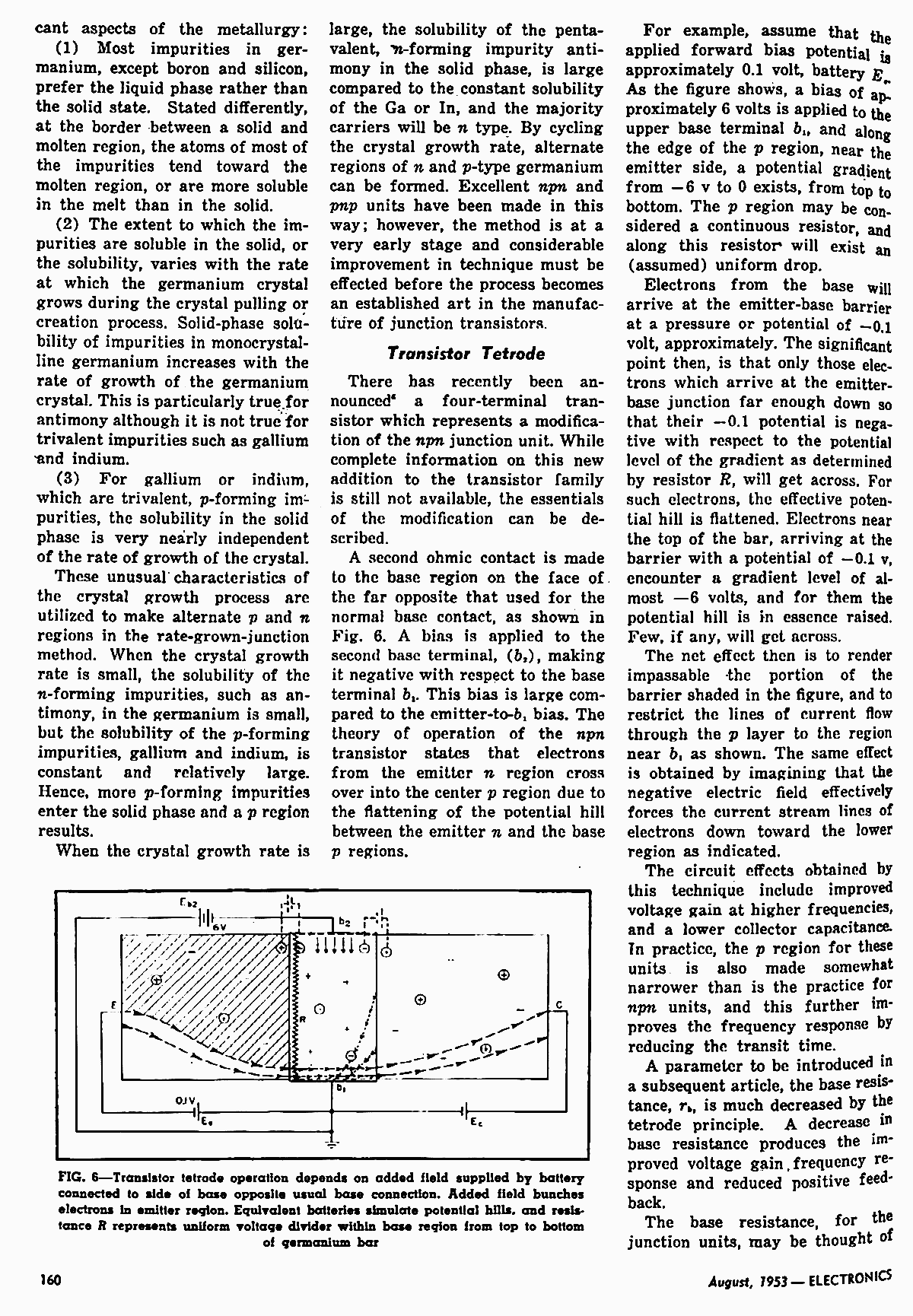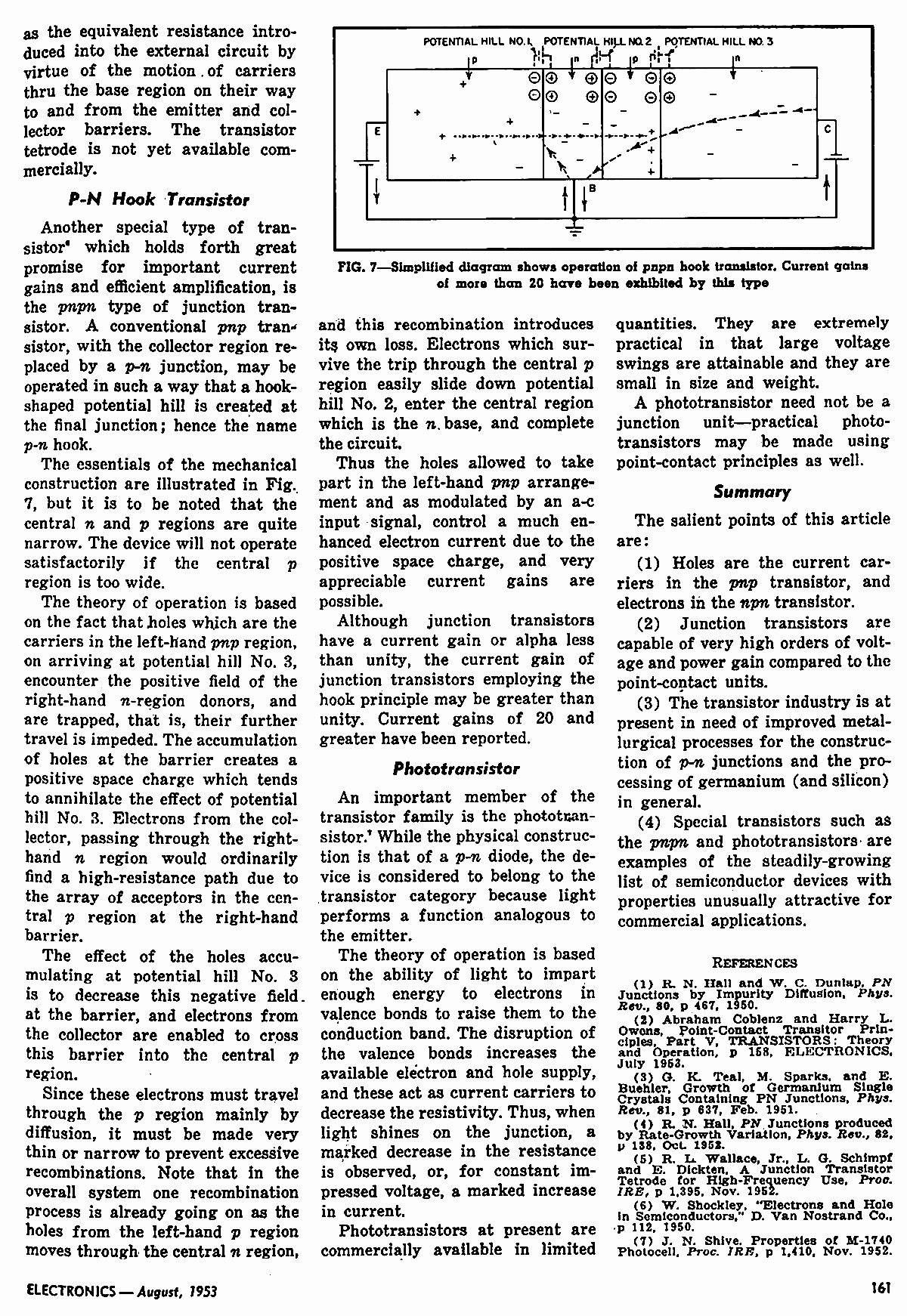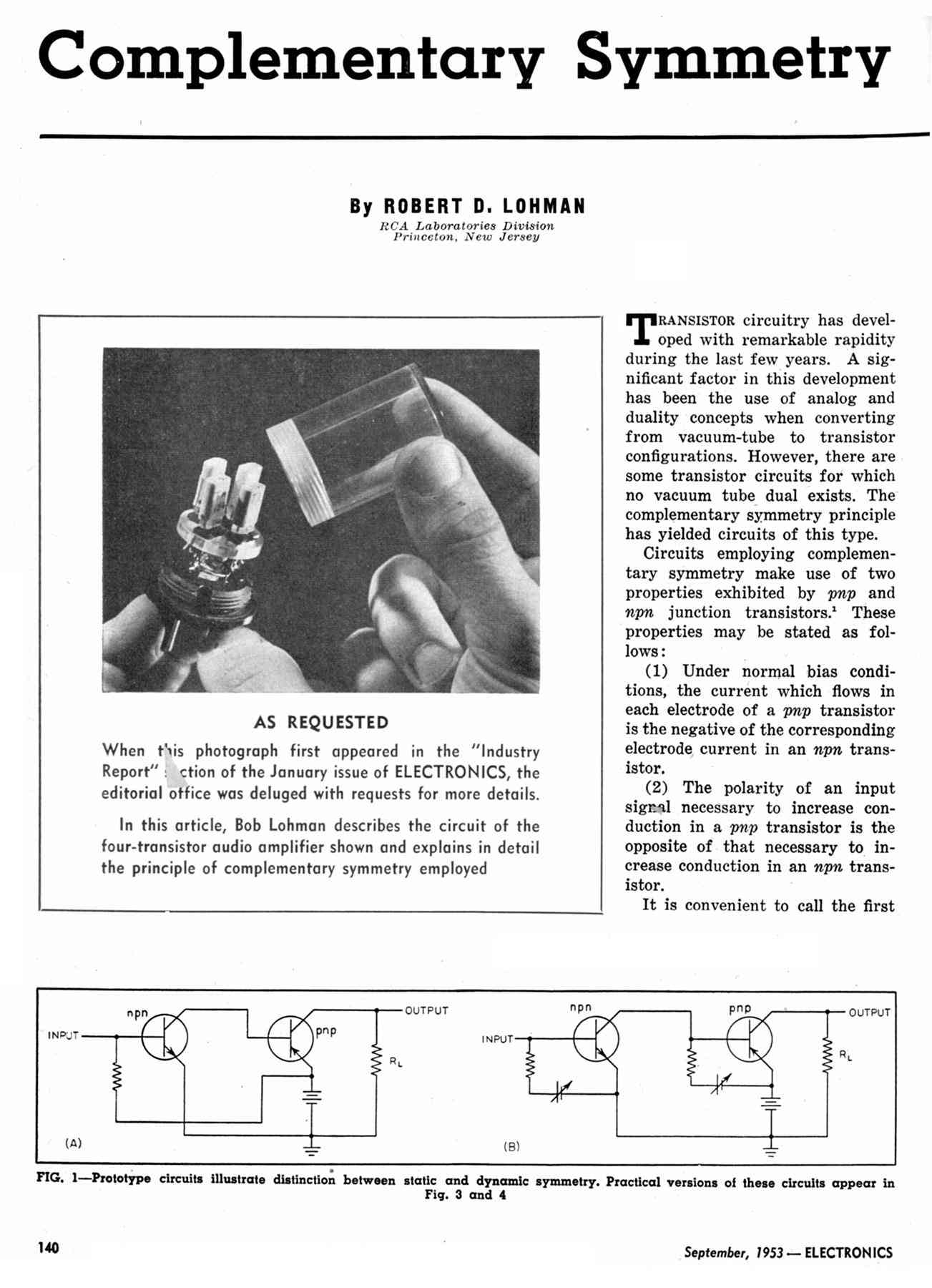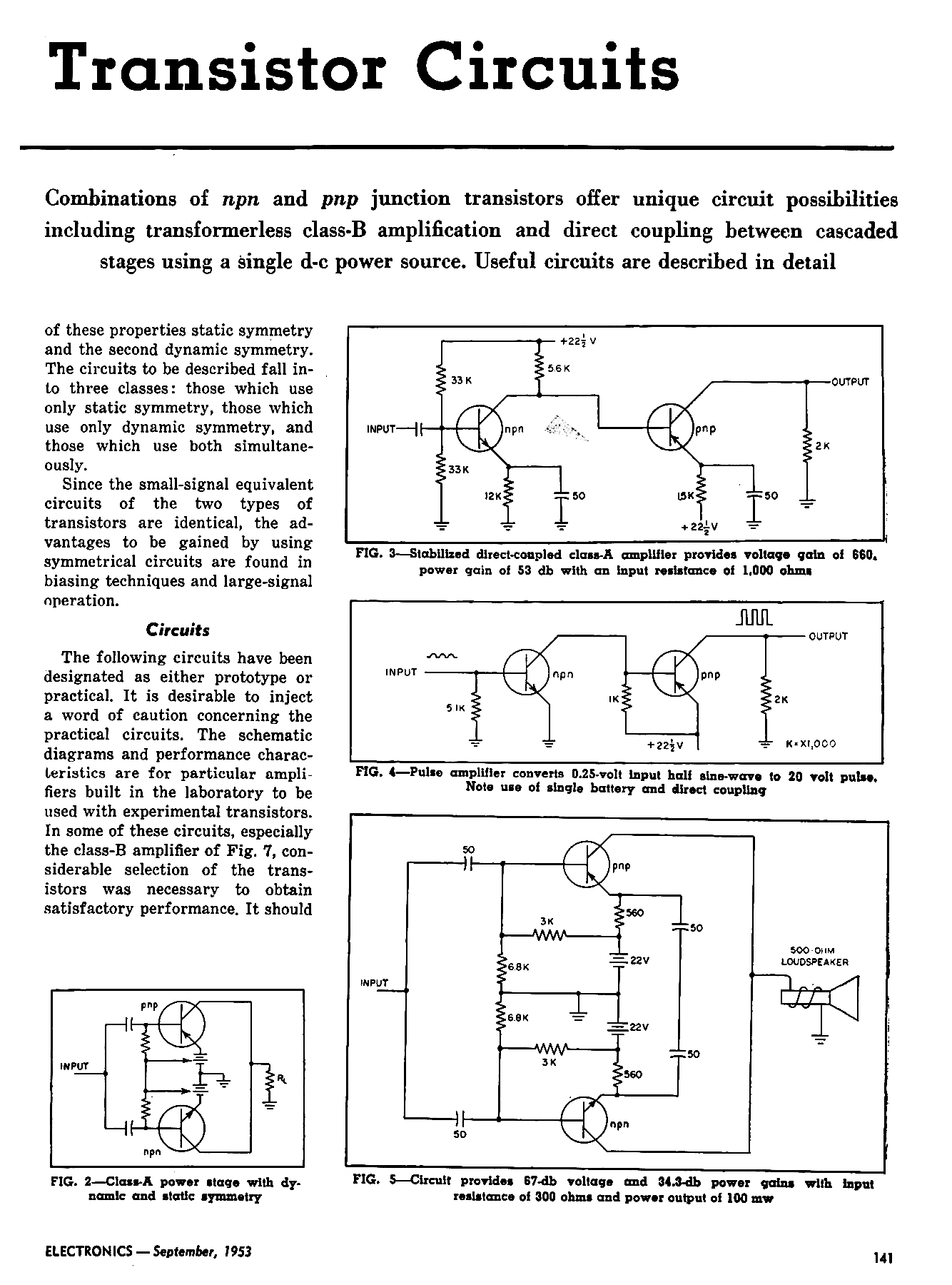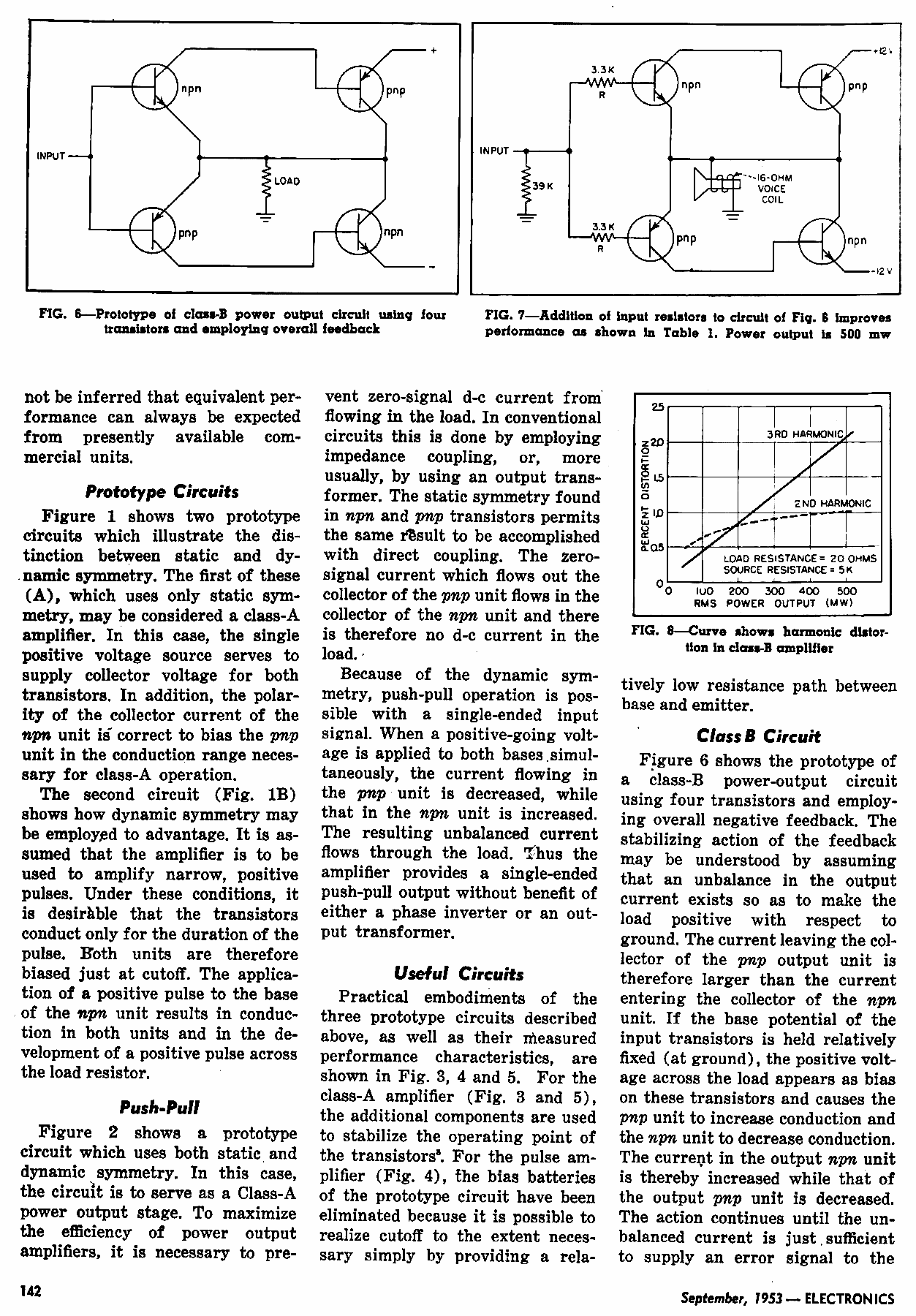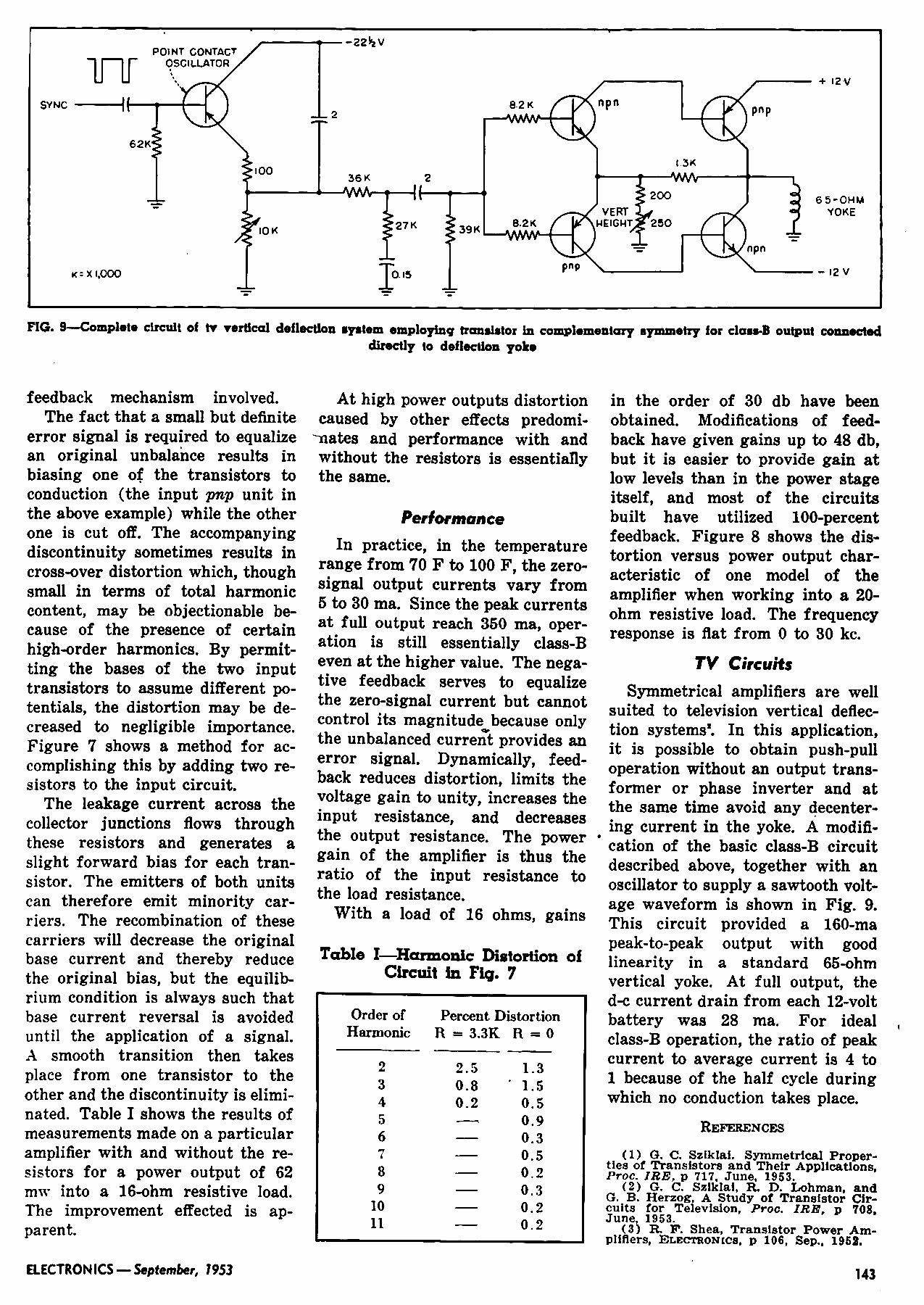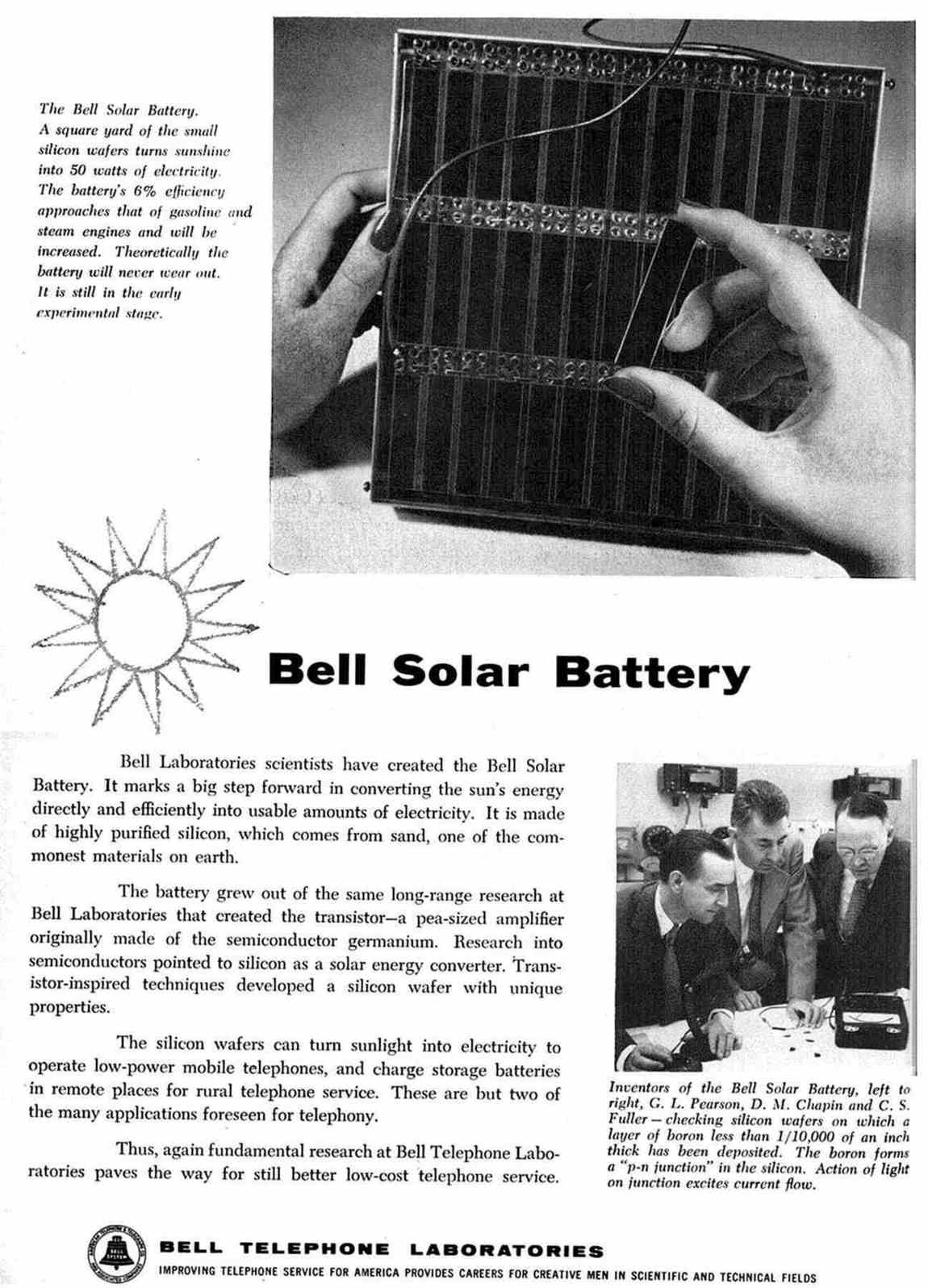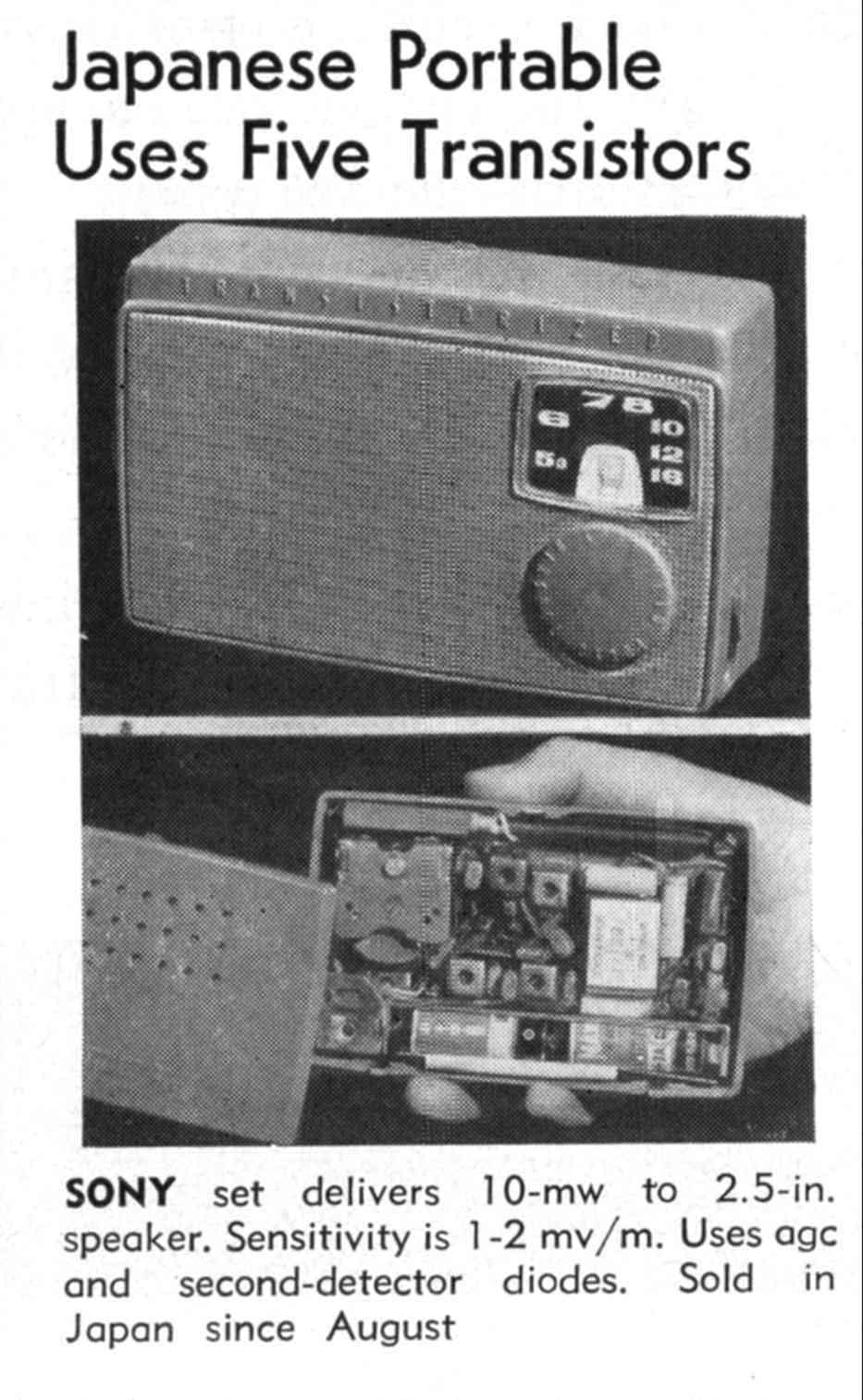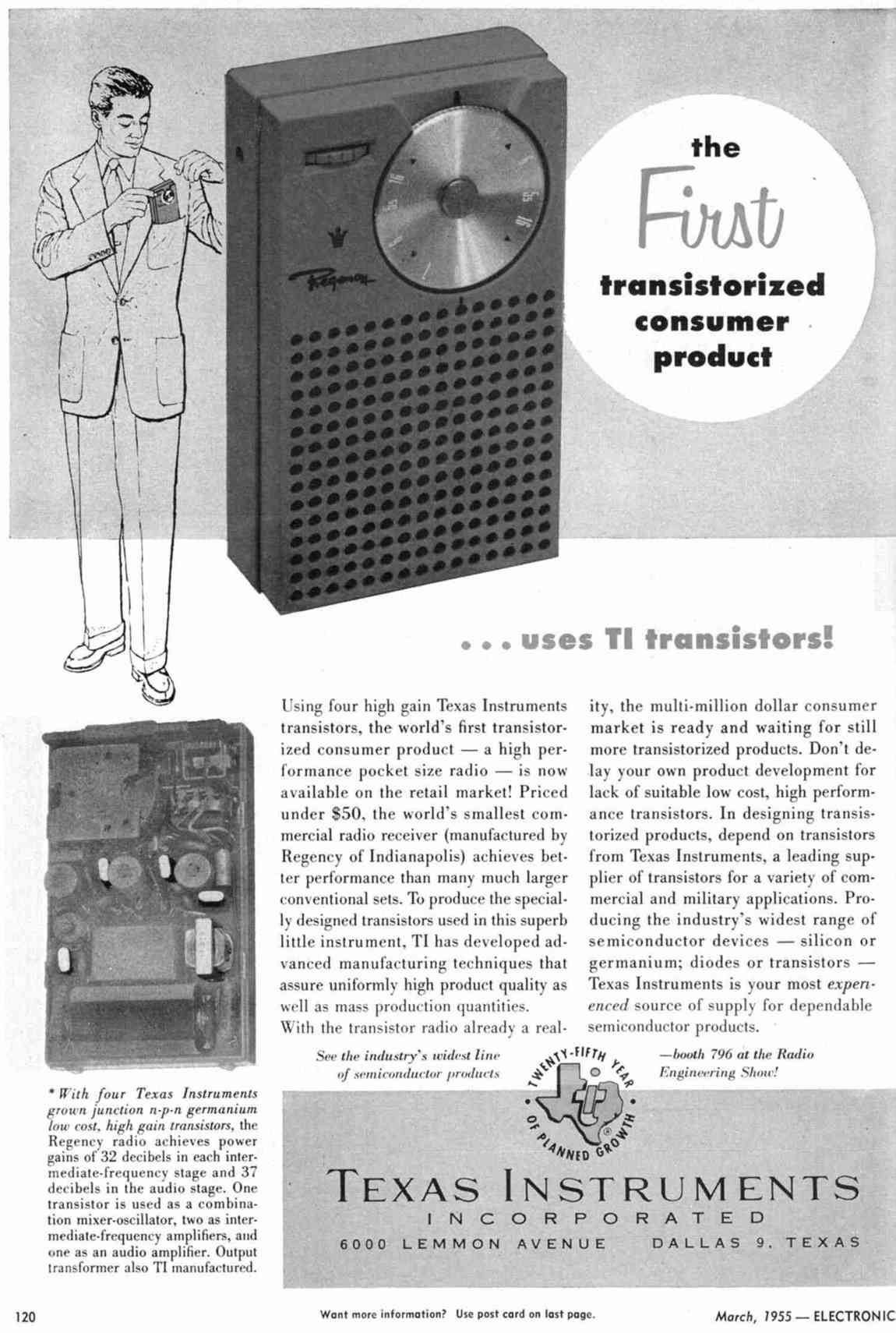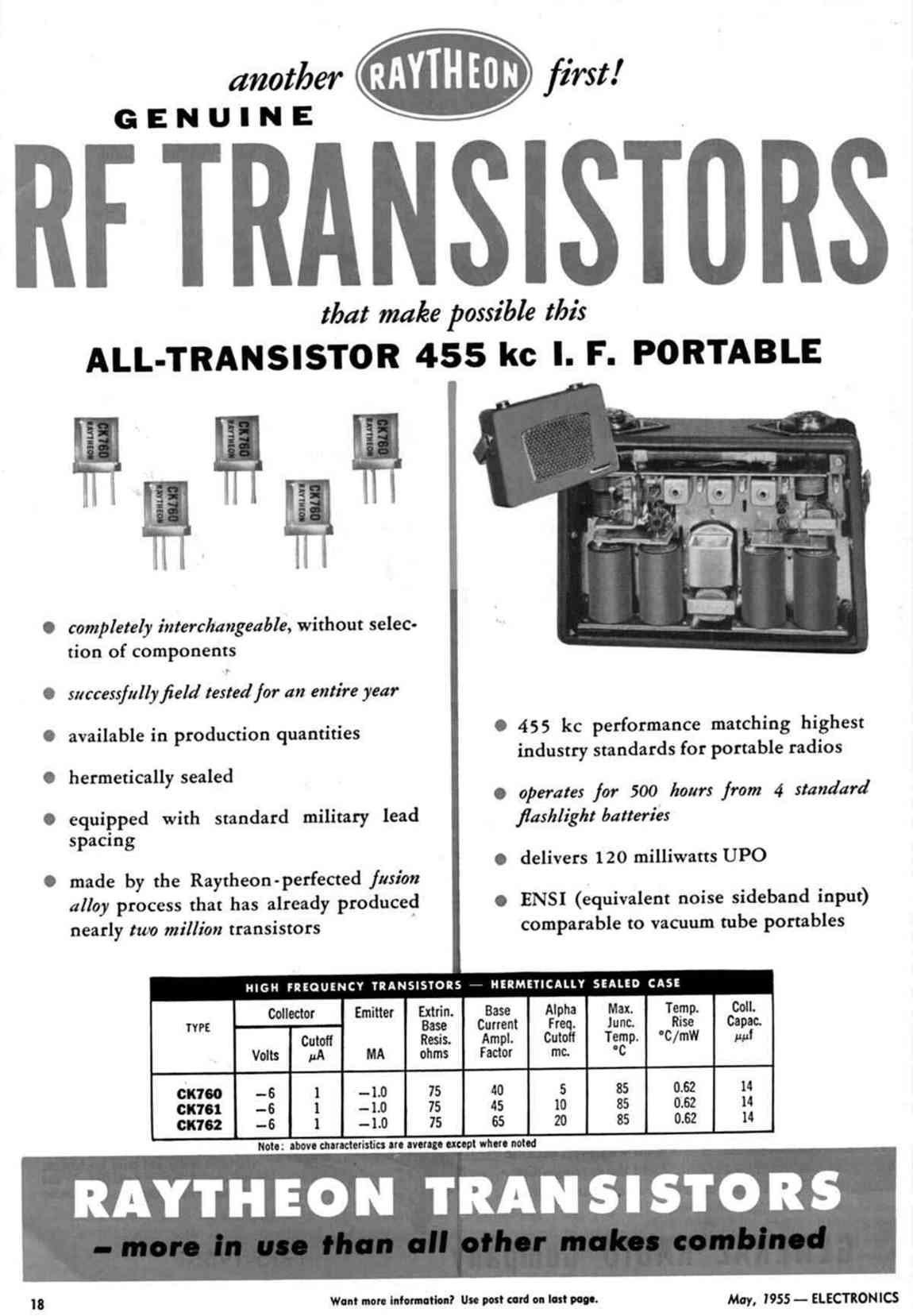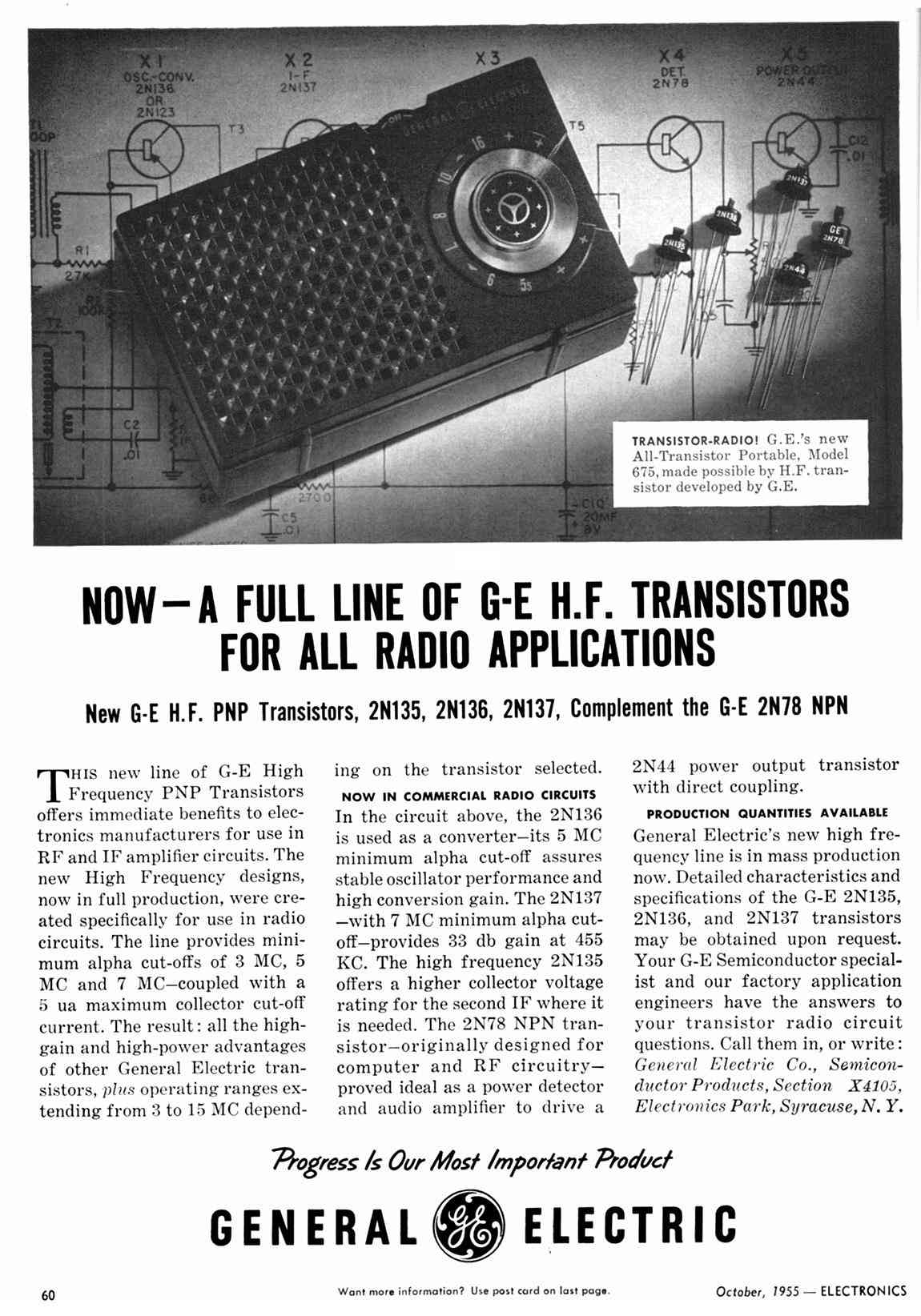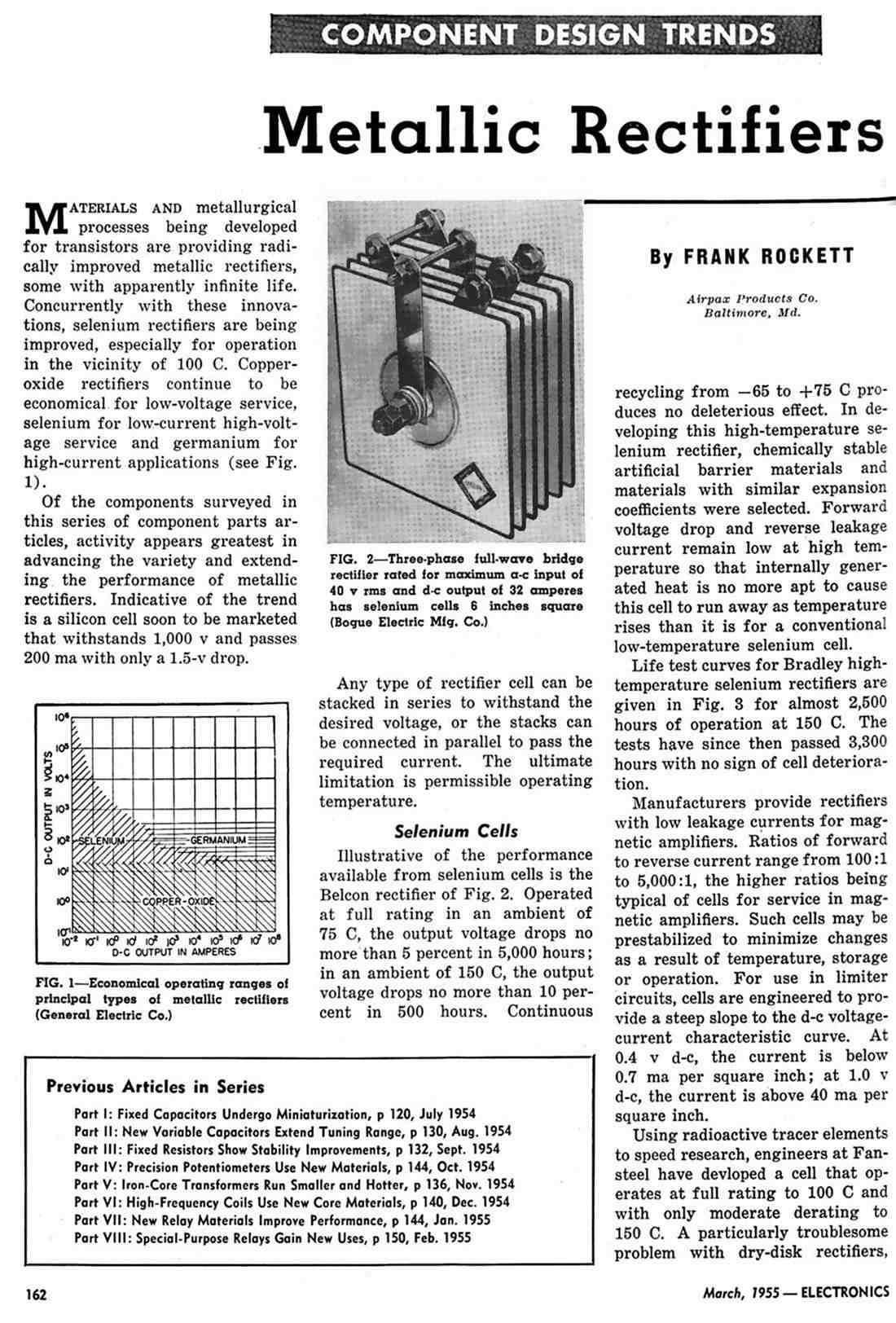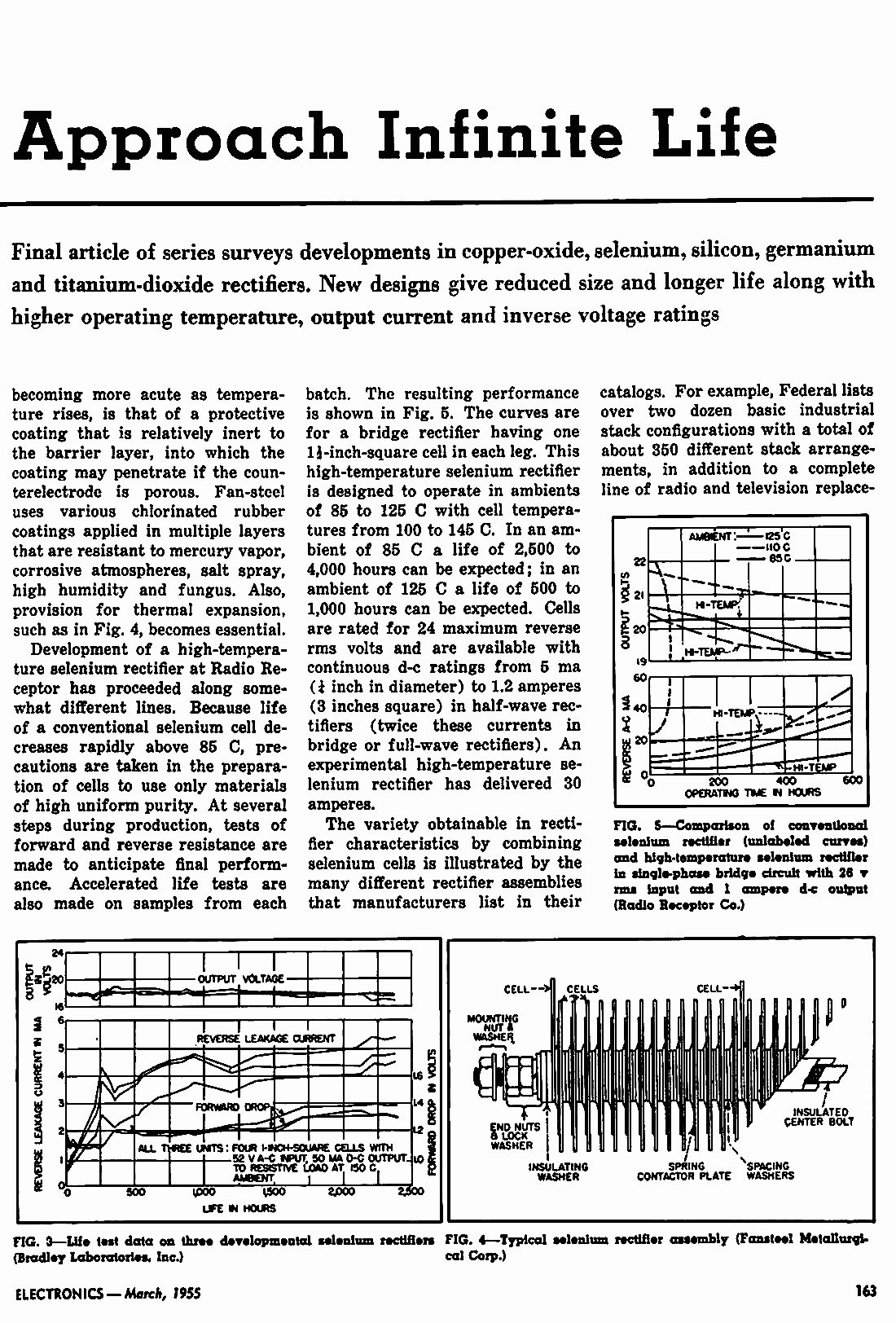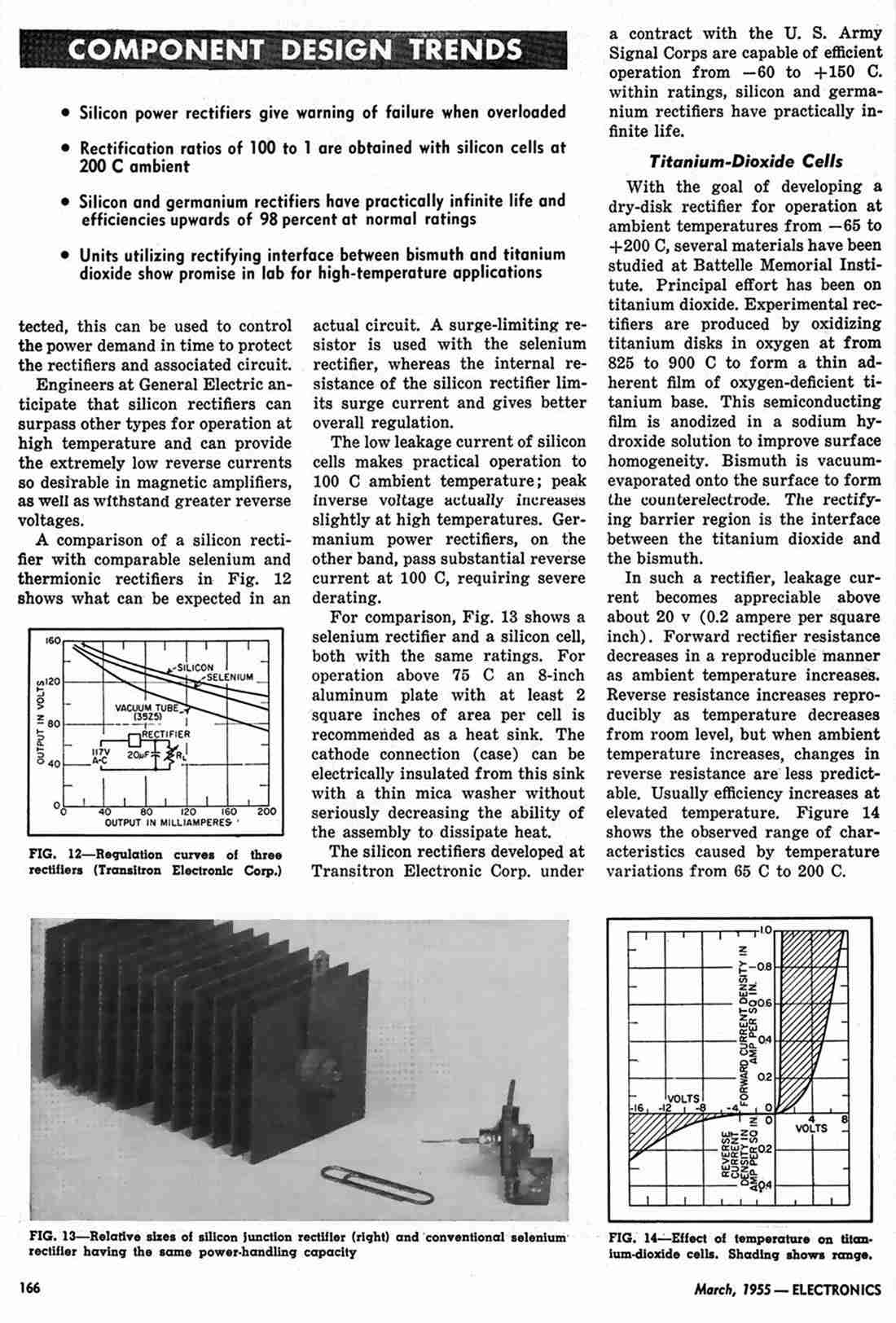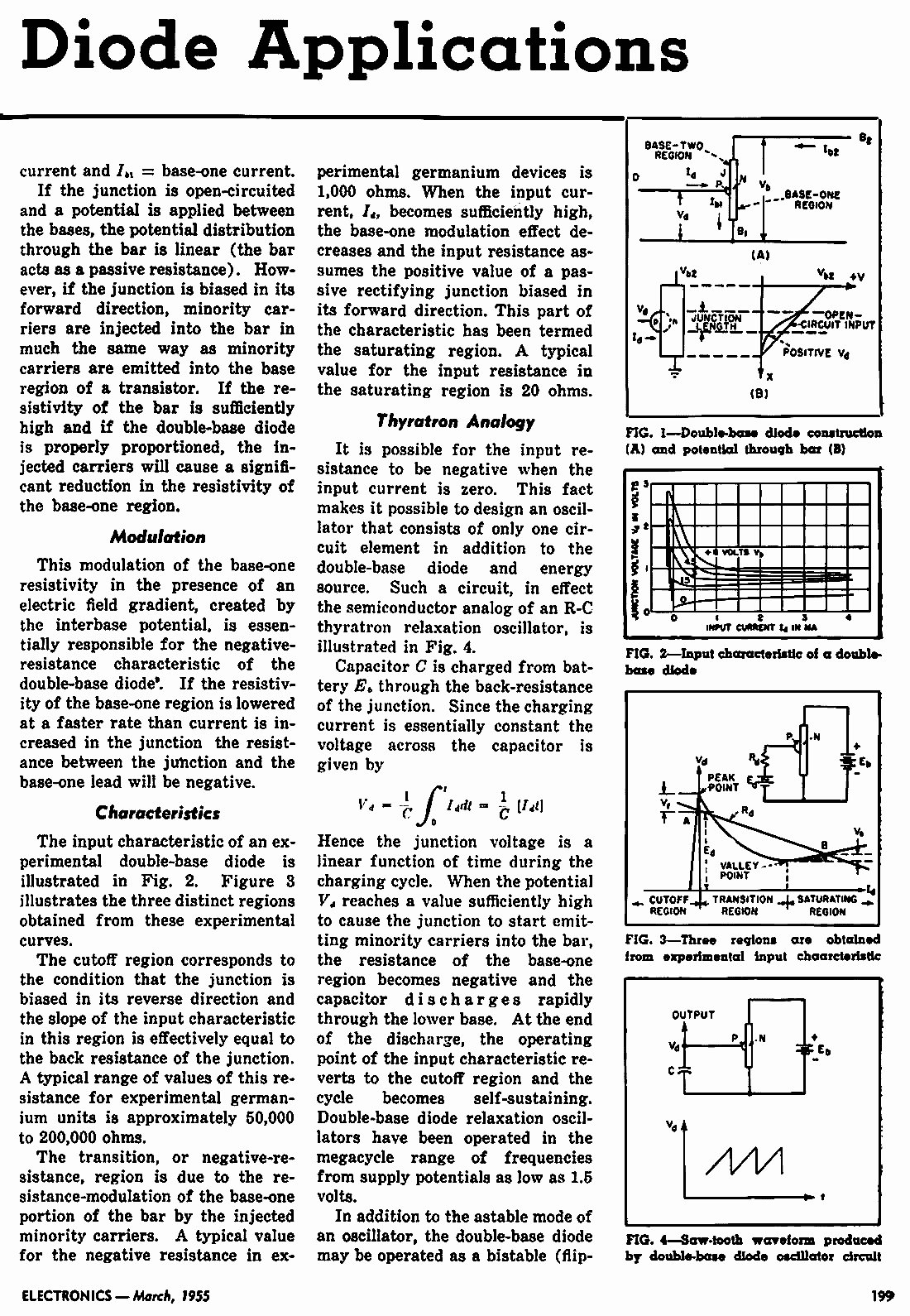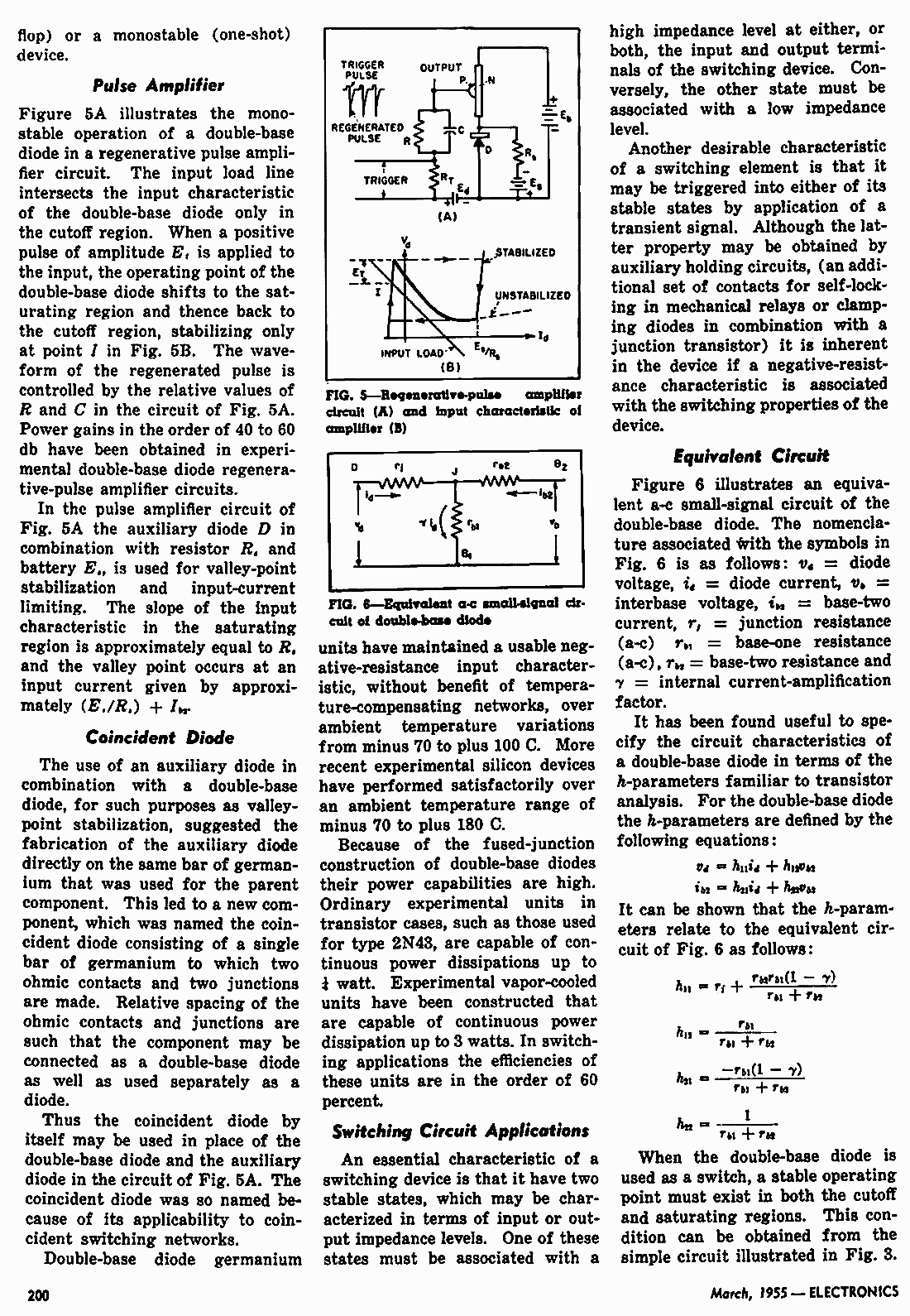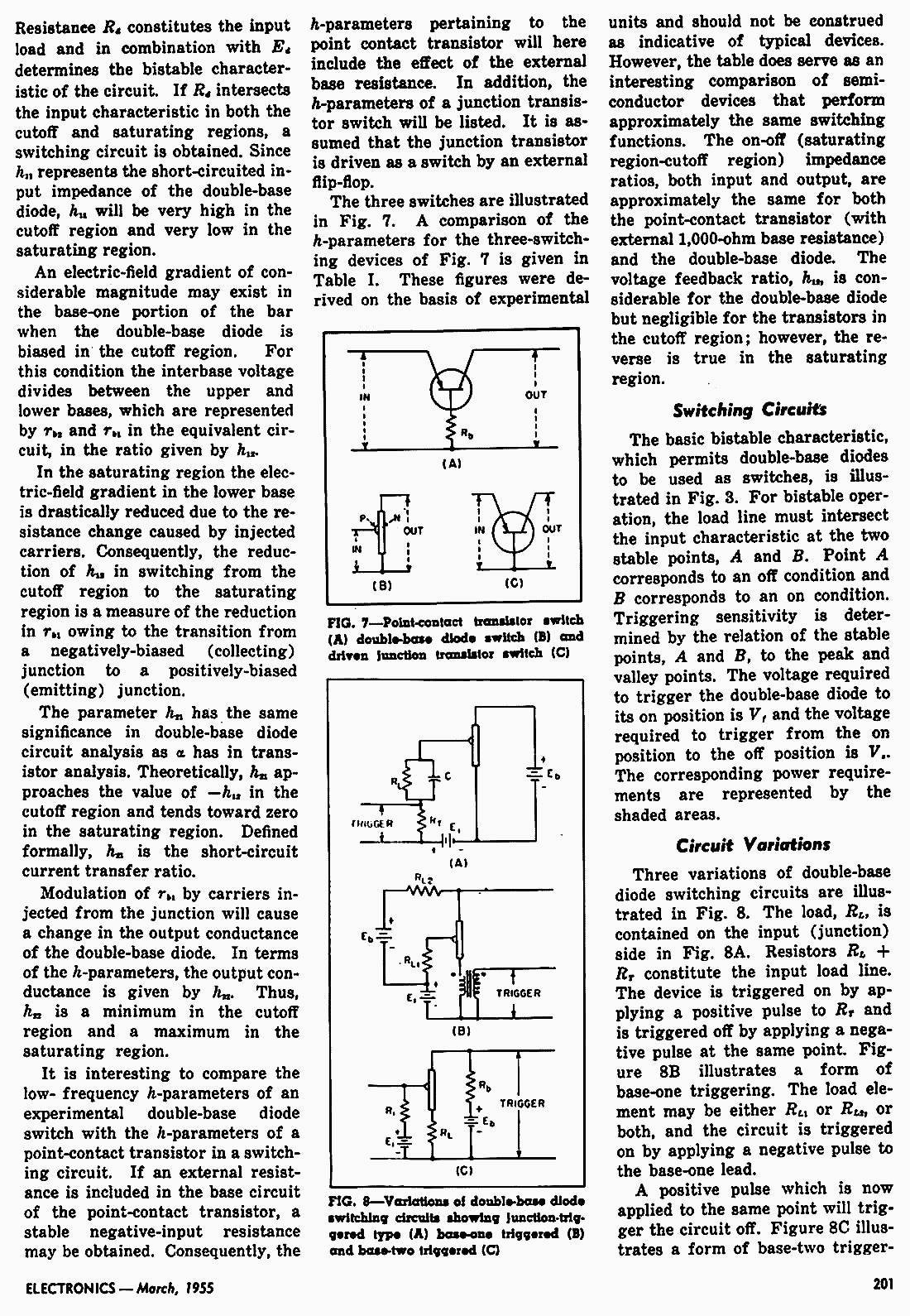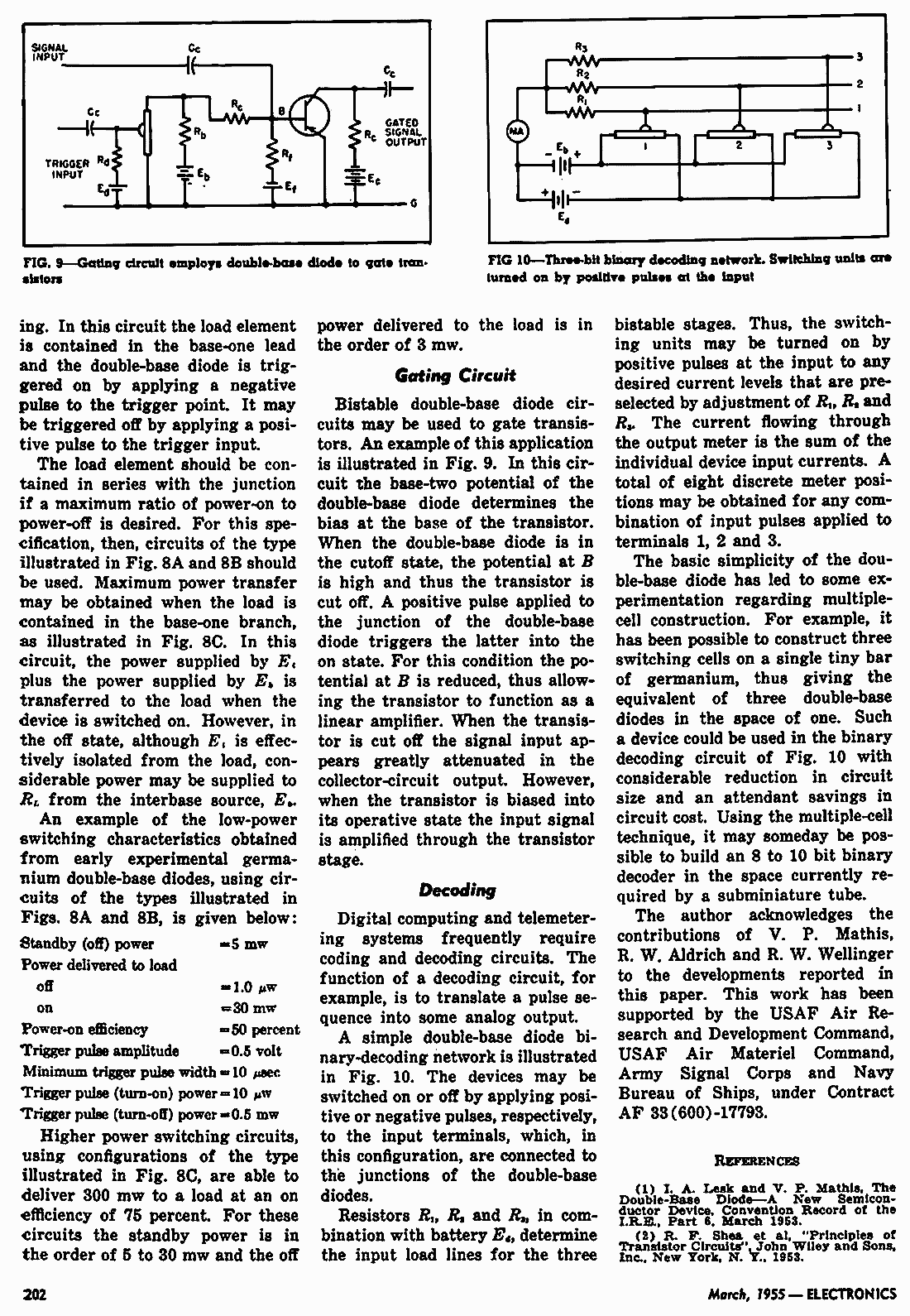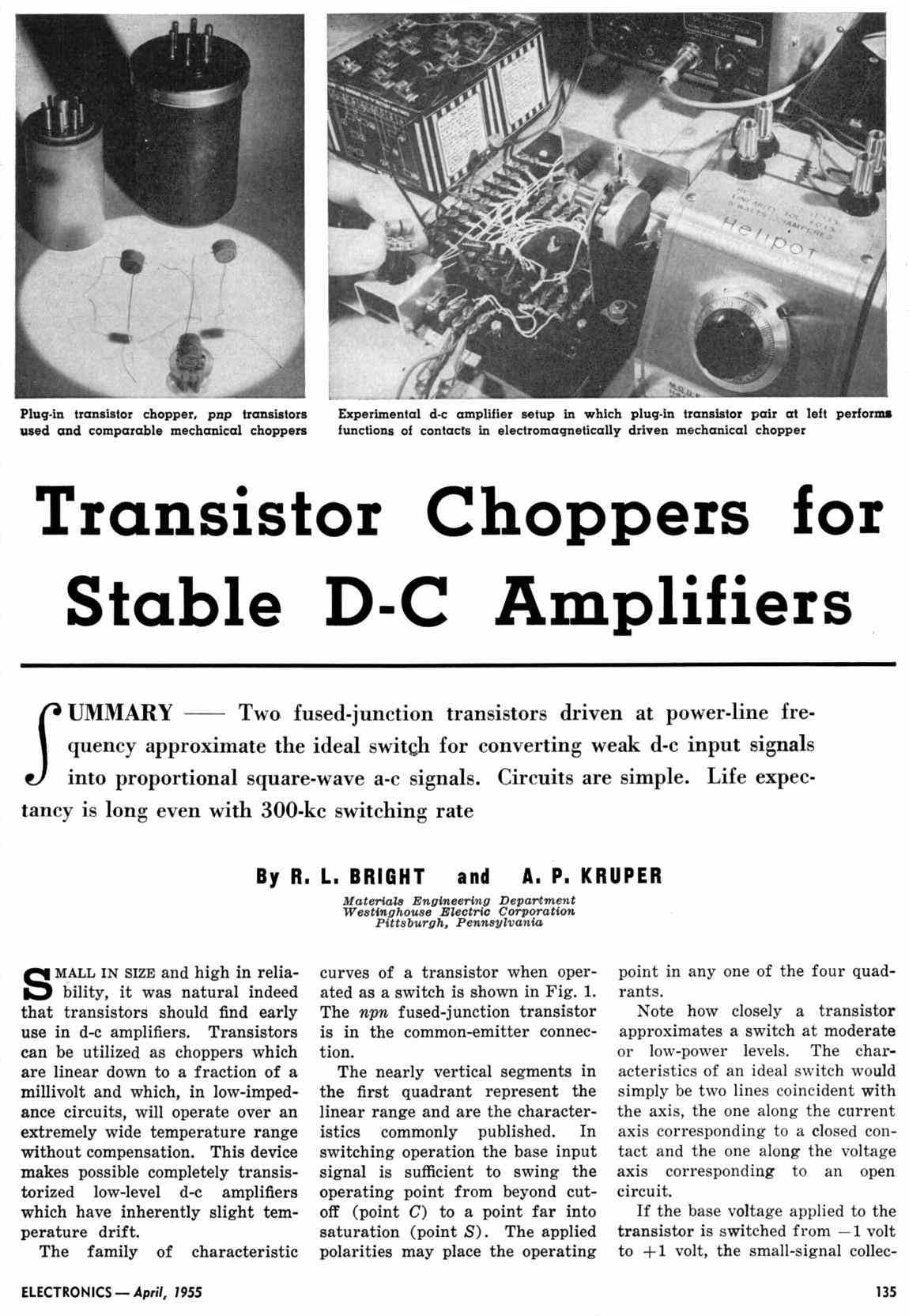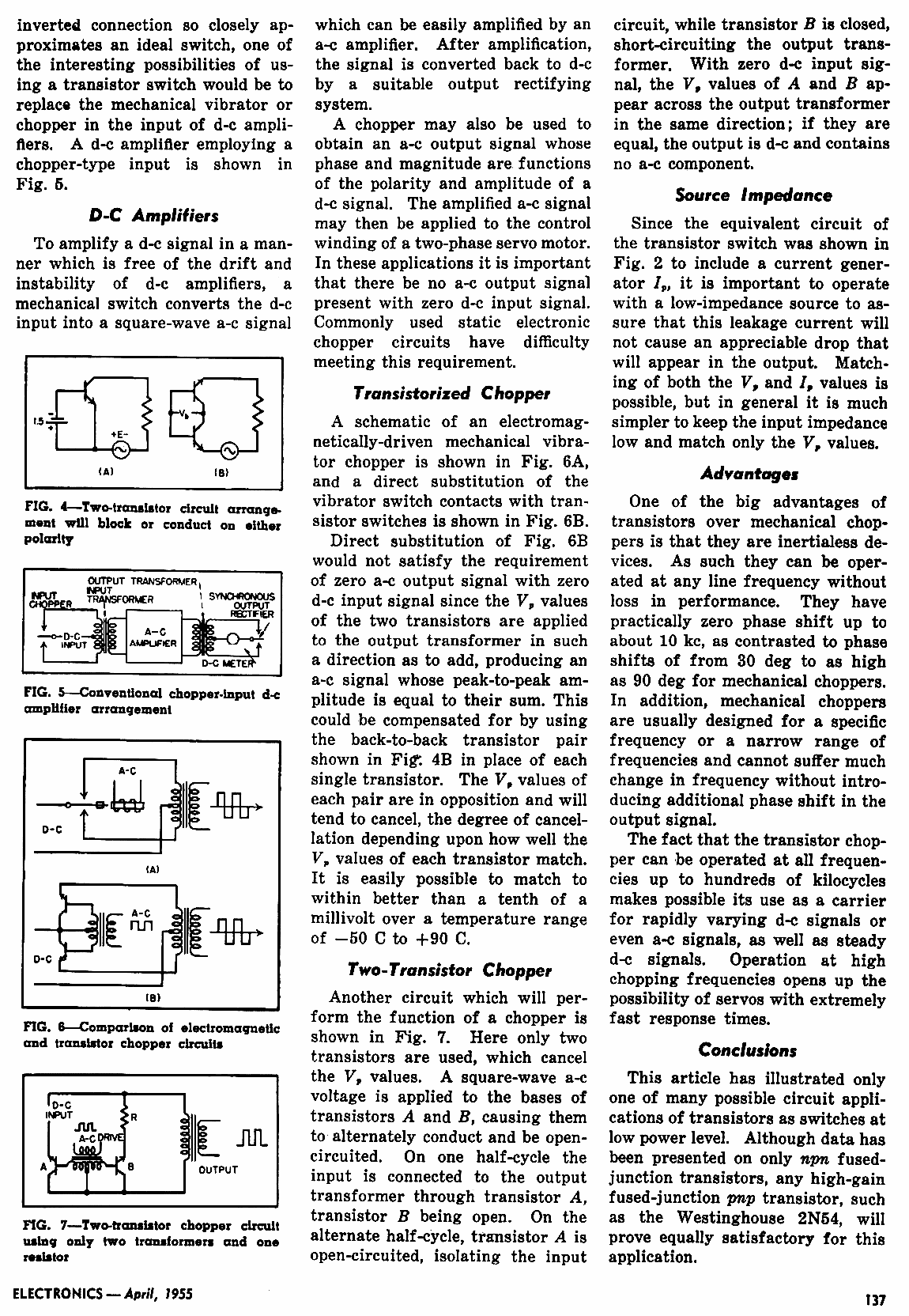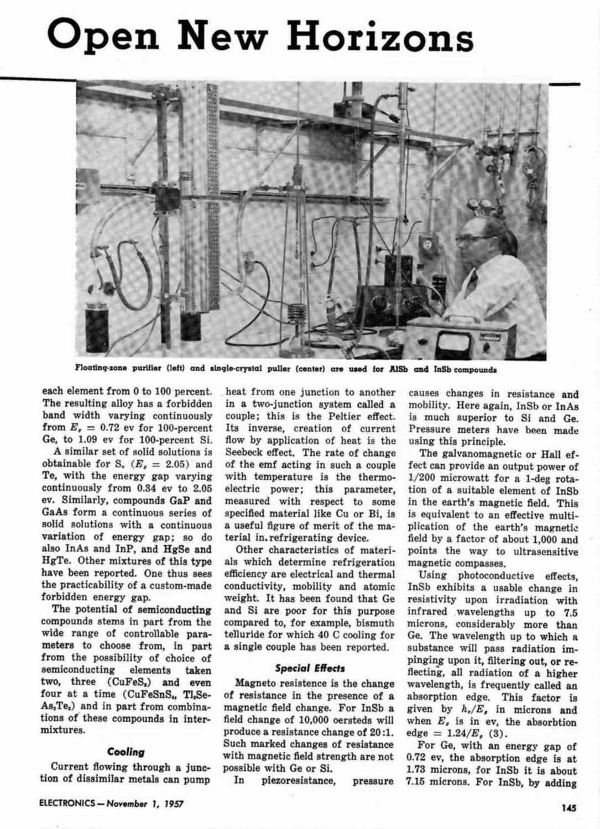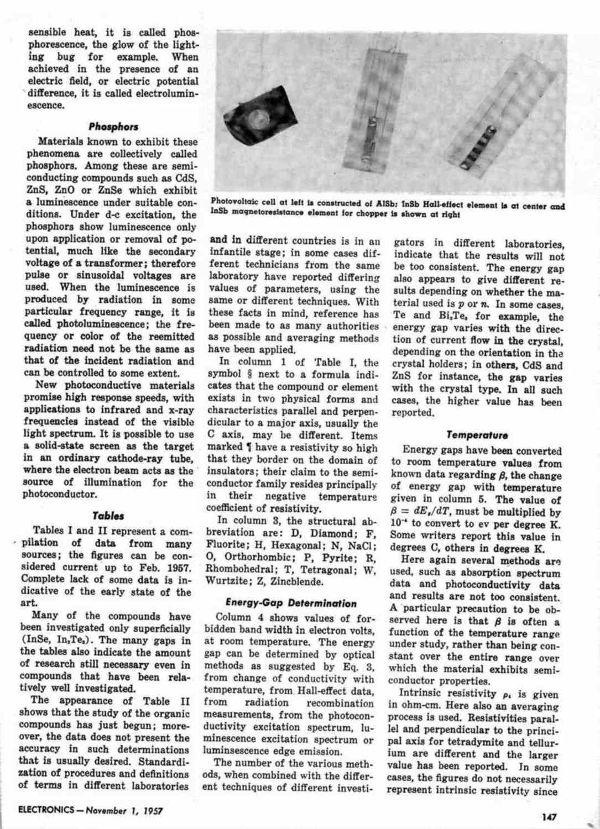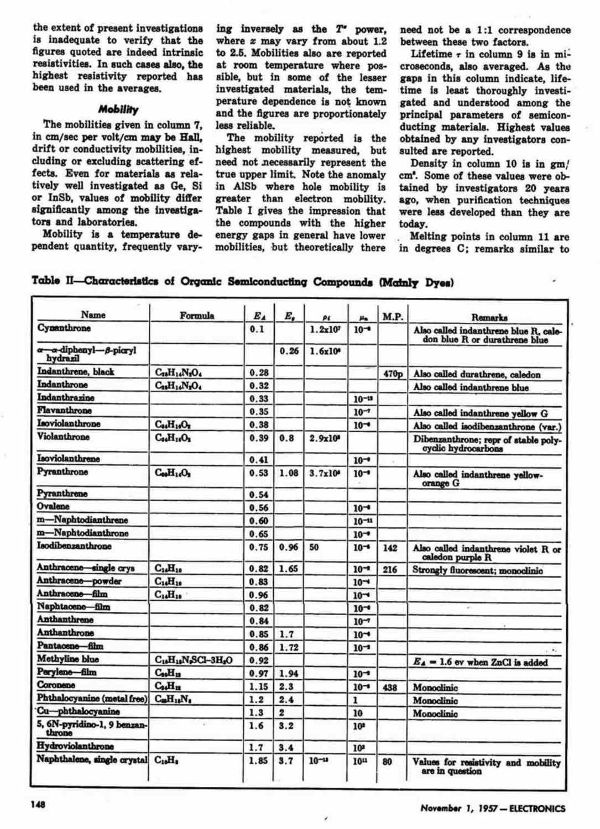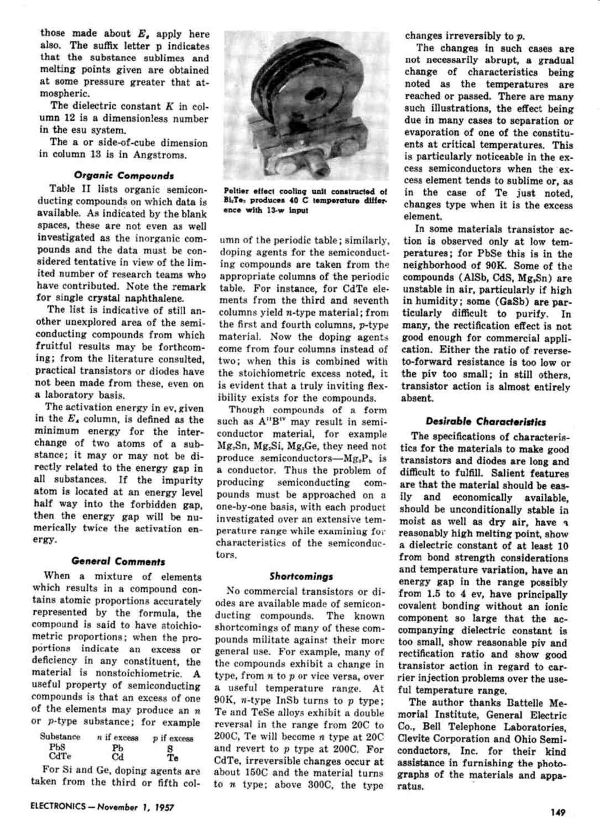Early transistor days
Early transistor days

Early transistor days - First Part
An interesting overview of the early transistor days can be derived from articles published in Electronics.
Until 1951 germanium and silicon semiconductors, diodes and transistors, were all of the point-contact type. Production was almost entirely run manually, adjusting the position and the compression of catwisker contacts over the semiconductor base, until acceptable direct-to-reverse current ratio was obtained. Silicon diodes were still identical to types in production through the war as microwave mixer or video detectors in radar gears. Germanium had been preferred for any other applications, due to its lower melting point and its simpler processing. Few manufacturers, some already experienced with the production of silicon radar types, produced germanium diodes. Here is a Sylvania advertising, covering their line of germanium diodes at February 1951.
![]()
In March 1951 Electronics published the list of all the diodes, both microwave silicon and low frequency germanium, available in US. Tables gave the entire catalogue of diodes in production at that date: a total of 13 silicon and 47 germanium devices. Note that some of them were just selections of basic types, as the matched pairs, or multiple diodes in a single package.
Just few words to depict what kind of devices came out from these productions. Very few parameters could be monitored during the assembly process, to stay within extremely wide limits. Full measurements were just performed later, after the encapsulation: each device was tested for some electric parameters, usually the reverse current or even the noise figure in mixer types. Then the code was decided according to the measured values. One diode could be marked as 1N38, while the next unit, returning higher reverse current, was marked as 1N34.
Point-contact semiconductors were noisy and unreliable devices. A current of few milliamperes could cause overheating in the extremely small contact surface. Shocks, vibrations, heat or even the simple ageing could damage them. In February 1951, Electronics listed some jargon words in use at that time to describe the antics of malfunctioning germanium diodes: creeper, dancer, dillidallier, wiggler and down-drifter. Any vacuum diode performed by far better than the best germanium type. According to the NBS, ‘only’ 5.4 percent of the 16,000 diodes installed in their SEAC computer had been replaced after 2500 hours operation: better figures were easily obtainable using 5726 or even commercial 6AL5 tubes. In October, total production of diodes was esteemed around 4,000,000 units a year.
We can argue how expensive could be a simple 1N34 germanium diode looking at the next ad. In a full page of the December 1951 issue, Sylvania proudly boasted the use of 29 diodes, germanium and silicon, in the ground receiving system installed at Alamogordo missile launching facility!
![]()
Coming to transistors, in 1951 just limited quantities of point-contact types were sampled to top customers and to universities, to establish the proper design approach. In March, a flash suggested a possible first use of transistors in computer trigger circuits. In August 1951, Electronics gave a detailed report of the Defense Department plans for basic research and transistors were on the top of the electronic needs.
‘…The transistor came from scientist who were concerned with the solid state, rather than from those who were trained in electronics. However, one can rightly argue that the future of the transistor, as an important component in electronic systems, depends on basic and fundamental investigation from the engineering rather than from scientific point of view’. From these words, the emerging feeling is that transistors were just being built in some research laboratories by the same people that were still characterizing them.
In November 1951 we find an interesting opening to the solid state transition by Louis N. Ridenour, who had been the editor-in-chief of famous reference textbooks, as ‘Radar System Engineering’ from the MIT Radiation Laboratory Series. Ridenour stated ‘there is nothing wrong with electronics that the elimination of vacuum tubes would not fix’.
![]()
In the same issue we find a first article on junction transistors. Just samples of this device, theorized by Shockley two years before, had been produced by Bell Laboratories. They were still experimental, but overcame many defects of point-contact types: they were low-noise, rugged, capable of handling high currents and had indefinite life. In the article was reported the very low power, 0.6 microwatt, required to operate a transistor audio oscillator. Ridenour himself was so impressed by this figure, equivalent to the power spent by a flea jumping once every eight seconds, to define it as the ‘lazy flea power’. Frequency of junction transistors was limited to some 5 megahertz, but higher limits were expected with future reductions of the base thickness.
Just a month later Electronics emphasized the rumor picked about a revolutionary germanium diode, using the same junction technique, capable of handling 200 milliamps continuous at 200 volts peak inverse voltage and to tolerate a surge of 10 amperes. The short article closed with the words: ‘Like we said last month, this germanium is something to reckon with; only it appears to be marching even faster than we thought’.
![]()
Transistors were going to be more than a laboratory oddness and Electronics gave a six-page article, entirely dedicated to the design of circuits, adapting them to solid state.
The same magazine, in the February 1952 issue, brought out an investigation under the title ‘Germanium – Threat or Promise to Electronics Industry?’. Editors interviewed about pricing and availability of transistors the six larger manufacturers: Western Electric, General Electric, Raytheon, Sylvania, Westinghouse and RCA. Even if different from each other, all the answers were negative.
Also germanium junction semiconductors were highly promising: diodes capable of handling 300A were being tested, but nobody had started productions of these devices.
A short industry report in June gave the latest NPA rules to sell transistor to research laboratories and customers other than military. Each customer could receive a maximum quantity of 50 pieces/month per transistor type. Very interesting was the table reporting production volumes, totalling each month about 8,000 point-contact and less than 100 junction types. Also interesting the picture of the solid-state megaphone developed by General Electric.
![]()
We can argue that in 1952 the future of semiconductors was not clear either to top customers or to the same manufacturers. In August, Electronics published a complete overview of Western Electric transistor types introduced since September 1949. From the tables, point-contact types were still listed as the sole options for high-frequency or switching applications.
![]()
Here is the full article:
Also RCA was announcing new point-contact transistors for high-frequency applications, including a type capable of oscillating at 225 MHz.
![]()
The Signal Corps, the first customer for semiconductor devices, assigned millionaire contracts to Raytheon, General Electric, RCA and Sylvania to develop new semiconductor types and related automatic production tools. Well, contracts also covered the development of point-contact transistors and production and testing machinery. Even machines to form catwiskers were expressly listed as objects. Nevertheless these contracts were fundamental for the future expansion of semiconductor industry.
![]()
By the way, Electronics in September reported a total of 26 domestic and 9 foreign licences under WE patents for transistors.
Junction semiconductors also showed an excellent sensitivity as light detectors. 1N77 was probably the first sensor built with the new process. In November 1952, Electronics gave a two-page article on the use of this tiny device in a punched tape reader.
To thank the Author because you find the post helpful or well done.
Part II

Solid state devices enter in military, computer and consumer fields. New families of semiconductors. Survey from ‘Electronics’ magazine, volumes from 1953 to 1955.
In 1953 the offer of junction semiconductors, before generally limited to evaluation quantities, began to ramp up, also including some ‘power’ devices. The following ad from Radio Receptor, later General Instrument, gives an idea of the offer at the time.

The symptom that something new was happening was the start in the pages of Electronics of a monthly survey on semiconductors edited by Abraham Coblenz and Harry L. Owens.
Very interesting is the article on junction transistors published in August that gave the details of the processes in use to get PNP and NPN junction transistors. Even if point-contact transistor were still in production, new transistors were either diffused-junction or grown-junction. The diffusion process, widely used through the coming years for germanium transistors, moved from a ‘N’ doped germanium die. The N die was the base; emitter and collector junctions were formed soldering the connecting wires with small beads of indium or gallium alloys over the two larger surfaces of the die. The process to manufacture NPN transistors was by far more complex, based upon the alternate addition of trivalent (gallium or indium) and of pentavalent (arsenic) impurities into a melt germanium mass while slowly pulling up a single crystal ingot. The ingot was cut into thin slabs, each containing one P layer in the middle of two N surfaces. Each slab was then cut into dices or small bars. The operator had to locate the P region and to weld the base contact wire to the side of the bar. This is the reason why, even in the sixties, popular germanium transistors were of the PNP type and just few NPN types were available for special applications.
Authors for the first time introduced the transistor tetrode, forerunner of FETs, even if such a device was not yet commercially available at the date. They also described a four-layer structure, pnpn, referred to as an ‘hook transistor’. In a short while this device should have originated the families of semiconductor switches, later known as SCS (Silicon Controlled Switch) or as SCR (Silicon Controlled Rectifier).
We also find an abstract from a presentation of Emerick Toth at the Naval Research Laboratory, Washinghton, D.C. discussing one of the very early circuits proposed for a transistor superheterodyne receiver.
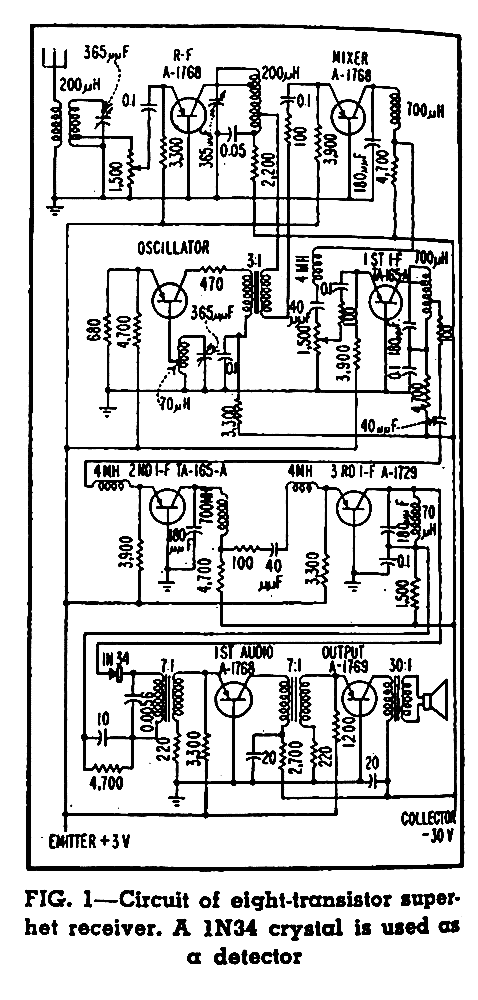
The article gave the design choices of an eight-transistor receiver covering the broadcast band, 550 to 1550 KHz, with 455 KHz IF. Three IF and one RF stages were used. No practical way had been found to add any AGC. The author stated that it was out of question until a variable-mu device would be made available. Even in this case, the current control circuit could have required a considerable number of additional transistors. The circuit operated with an emitter bias of 3 volts, 8 milliamps and a collector supply of 30 volts, 30 milliamps. As in many of the high-frequency designs of the time, transistors were of the point-contact type.
Army Signal Corps. had developed prototypes of wrist radios, one described in the October issue. The radio, powered by a small mercury battery, used a transistor regenerative detector followed by other transistors in the audio amplifier. It was capable of receiving stations as far as 40 miles covering the range from 1000 to 1500KHz.

New circuit architectures were investigated, as the Complementary Symmetry transistor circuits that required very few passive components. This architecture would have originated later the well-known families of COSMOS (RCA) or CMOS (generic name) digital integrated circuits. Here is the first article by RCA detailing the principle and practical circuits.
Despite the generic interest for solid state solutions and the claimed benefits just round the corner, in 1953 use of transistors was still confined in prototypes operated in controlled environments, often inside research laboratories. Transistors were too expensive for consumer electronics and not reliable enough for military applications. The new F-86D fighter still used 495 vacuum tubes to automatically fly toward the target and back to landing, as reported by Electronics in September 1953.

Nevertheless the solid-state migration was in the air. Whenever size and weight were a premium, new designs favored the introduction of solid state devices as far as possible. In December 1955 we find an article describing a new solid-state airborne computer by North American Aviation and a transistorized torpedo guidance by Westinghouse. Of course their designs had been necessarily started well before, when their feasibility was just a bet.
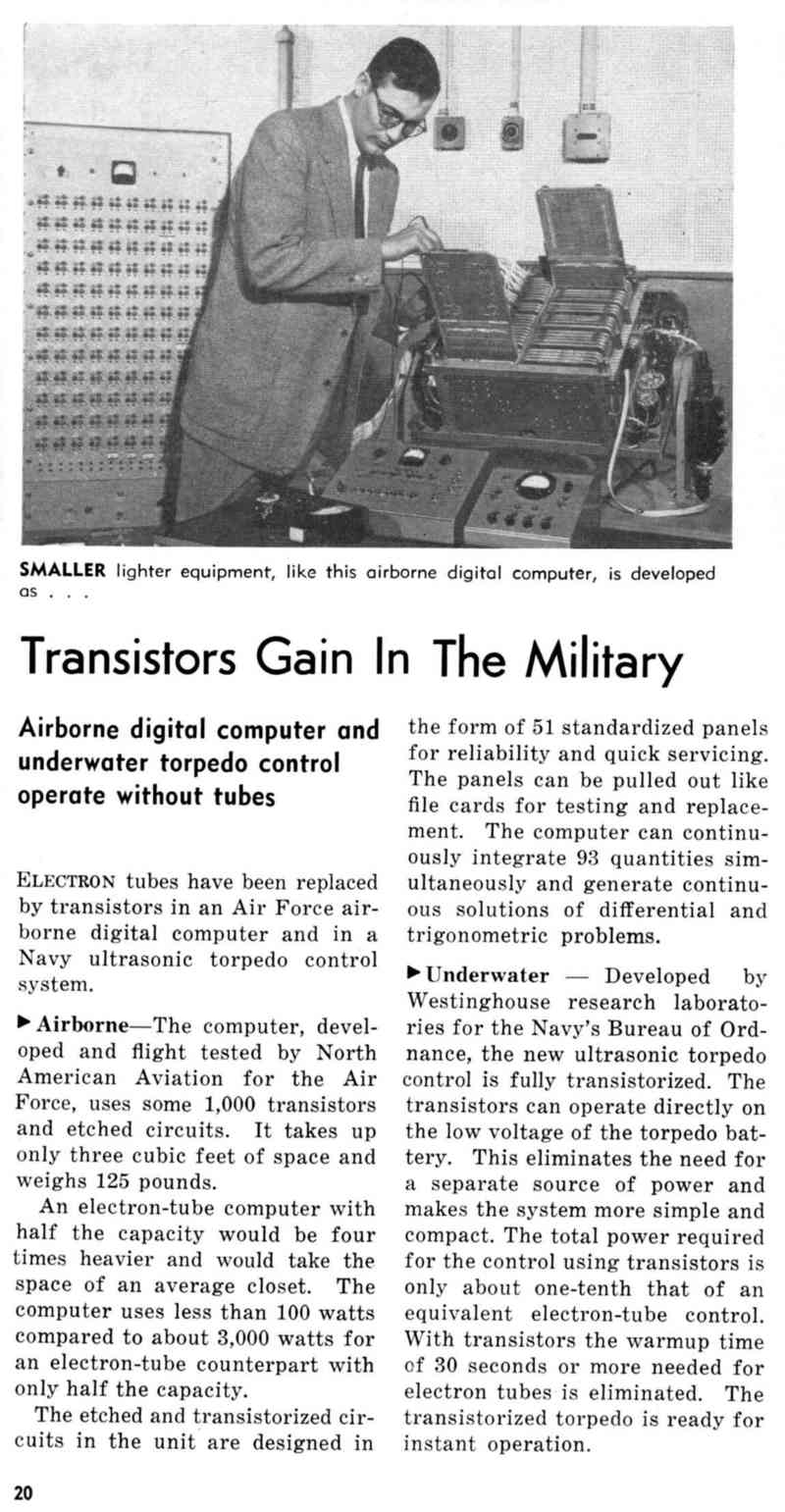
In 1954 we find another important semiconductor device created by G. L. Pearson, D. M. Chapin and C. S. Fuller of Bell Telephone Laboratories, the solar battery, first announced in July. Few months later solar cells were used to power a rural telephone system.
We learn that in the mid 1954 production volume production of transistors was rising. General Electric was in progress to complete machinery to process rate-grown germanium ingots. Production capabilities were expected to jump from about 2000 transistors in ten days to some 2000 units every two hours. Raytheon announced the production of its millionth junction transistor in August. We also learn that the great majority of transistors had been delivered to the hearing aid industry: about 300,000 out of 1,200,000 hearing aid wearers had just migrated to solid state devices.
In October 1954 we find a new transistor from the Bell Labs, with an additional layer of pure germanium. The ‘pnip’ transistor was capable of operation in the UHF region and oscillation at frequencies as high as 3 GHz could be expected. Probably this device, with its intermediate layer, originated future high-speed semiconductors, as the Schottky barrier logic circuits.
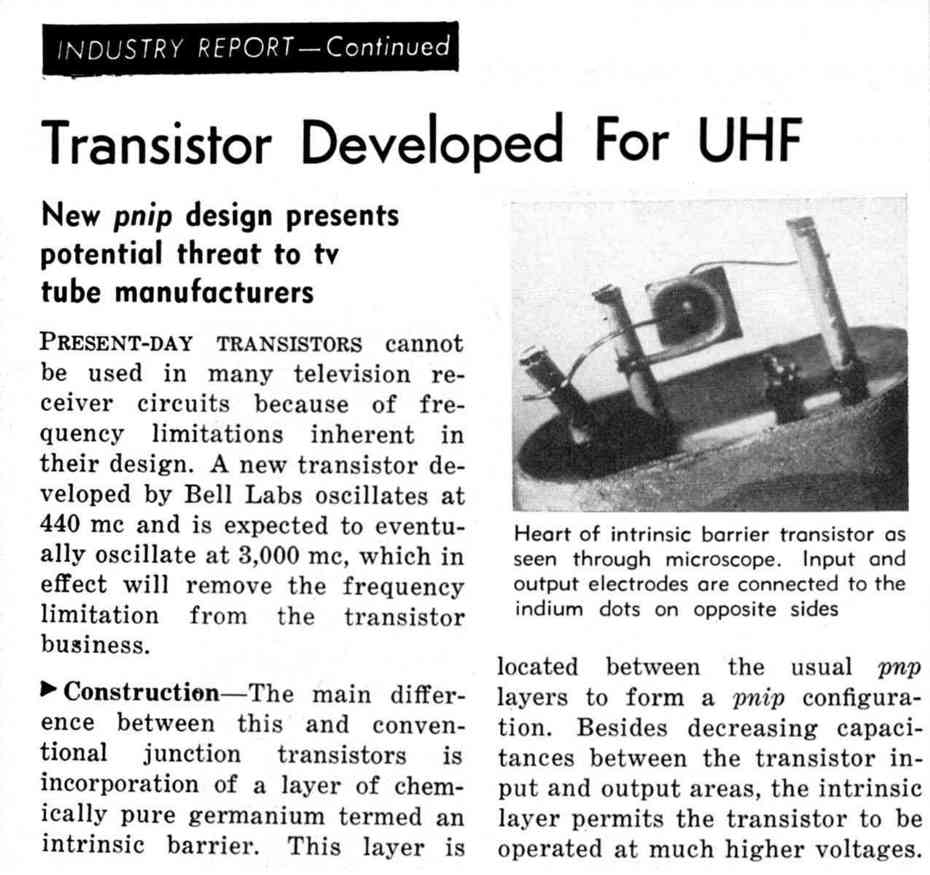
Several companies offered transitor tetrodes for high-frequency operation, while working to improve the frequency response of three-electrode devices. Sylvania had even announced transistor pentodes for use in some computer circuits. We find a price list from Germanium Products Co. that help us to understand the progressive growth of the offer. Here a transistor tetrode capable of operating at 60 MHz was sold for 40.00 dollars apiece, but low-frequency types were offered for as little as 3.00 dollars. This was a very attractive price indeed: five years later, in 1959, I should have bought my first OC71 Philips transistor for 3600 Italian Liras, about 5,50 US dollars.
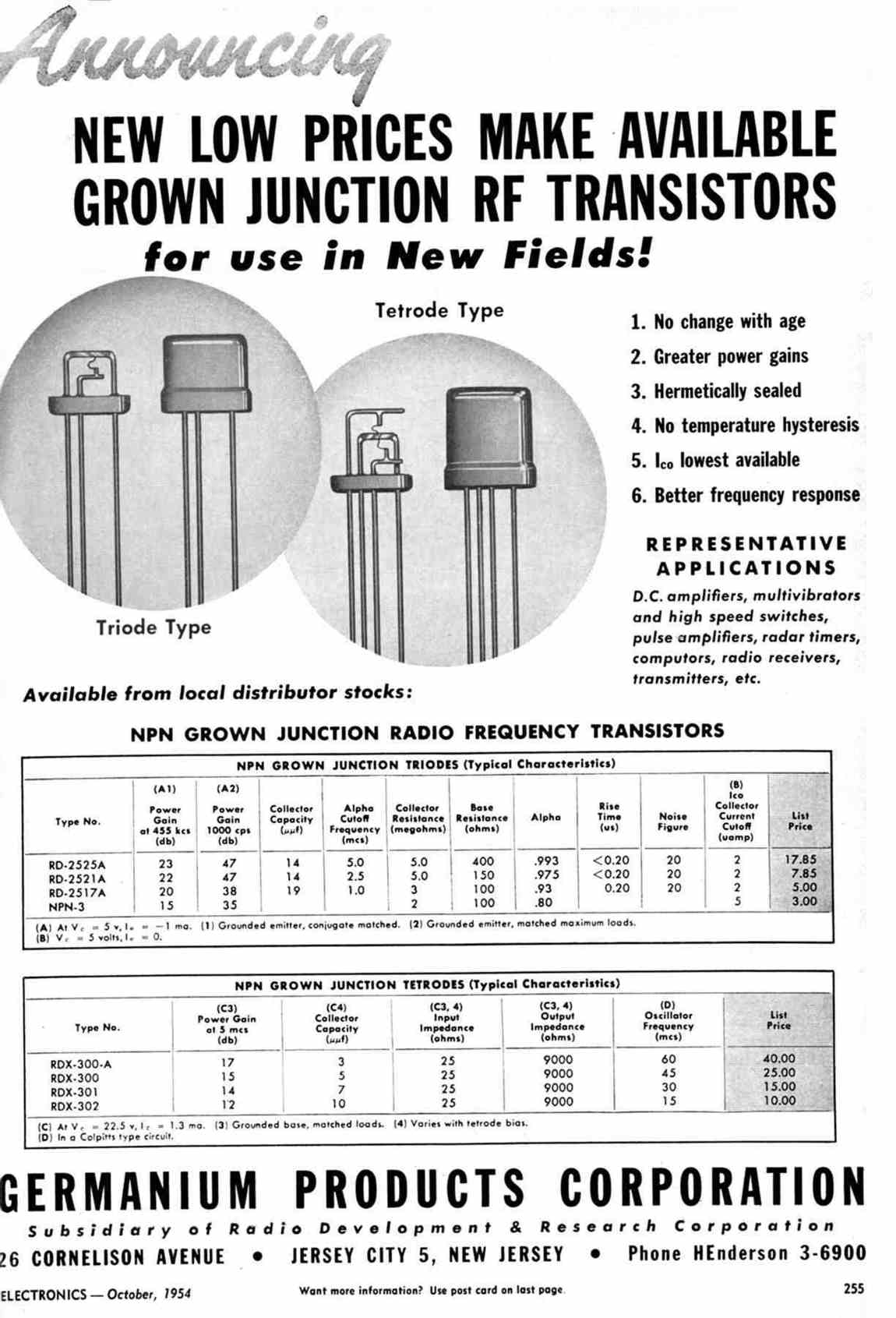
1954 was the year of the first solid state commercial radio sets. The design steps were complex, involving the development of new components, as low voltage capacitors and low impedance transformers, and of new mounting techniques, as the use of printed circuit boards. Regency won the race thanks to some compromises in its TR-1. The radio used only four npn grown junction transistors supplied by Texas Instruments. A short article also listed the suppliers of the various special parts, including transformers (both AF and IF), tuning capacitor, speaker, volume control and ceramic capacitors. Raytheon had already sampled working prototypes but was not ready for volume production. In the same forum thread we can see even the prototype offered to the governor of Massachusetts. The architecture devised for this radio would have fixed the standard of transistor radios for the years to come. Few months later, in the mid 1955, we also find the first Japanese radio. We can also see other US transistor radios, as Mitchell Manufacturing 1101, introduced by Electronics in August 1955. In the same article we also learn of many other consumer products, including a golf ball with a self-contained locating transmitter.
Junction transistors were also being considered for use in the computer market. In November 1954 IBM announced its experimental medium sized 604 machine, using 2200 pnp transistors mounted on 595 printed boards. Few months later this machine gave origin to the production of the 608 mainframe, available for delivery to customers early in 1956.
In March 1955 Bell Labs introduced a new finding machinery to automatically welding the connection wires on the semiconductor bars used in transistor tetrodes.
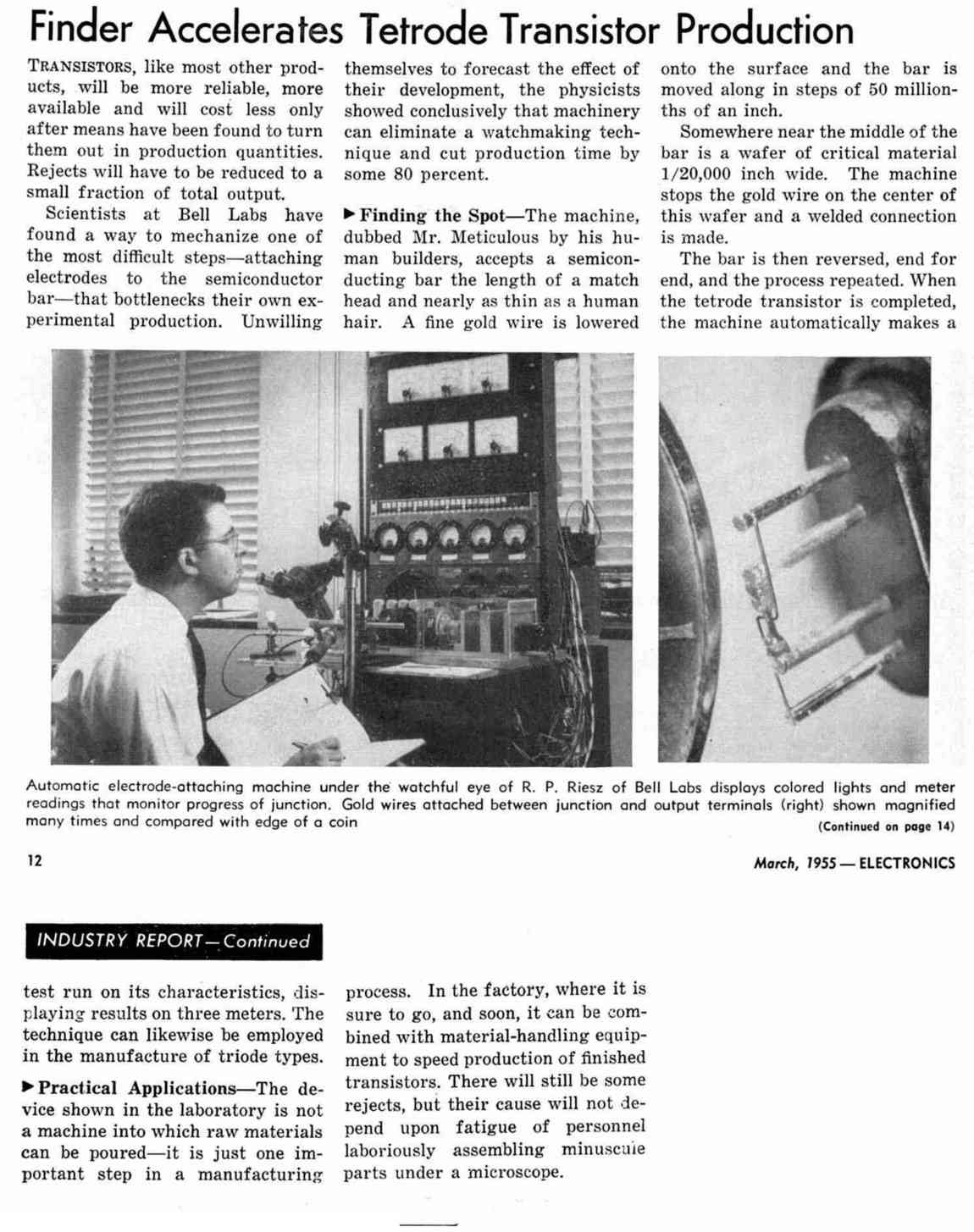
Improvements in production techniques were rapidly pushing up the use of transistors in consumer fields. Here the ads of the most known manufacturers for their transistor lines designed for solid-state radio sets.
For high-current diodes germanium was still preferred to silicon, due to its lower forward drop. Silicon was used for currents under 10 amperes, while General Electric offered germanium diodes capable of handling 85 amperes DC. Unfortunately germanium devices were easily damaged if the junction temperature reached the melting point of the indium alloy used to make the junction, about 85ºC. For this reason military pushed for more reliable silicon rectifiers. The tendency was rapidly changing as new power cases became available, usually large studs, characterized by low thermal resistance. The production of both germanium and silicon rectifiers was also pushed by the shortage of selenium, still used at the time for the most popular solid-state rectifiers.
In 1955 Electronics also gave the announcement of a new semiconductor device, the ‘double-base diode’, later known as unijunction transistor. Unijunction transistors would have been very popular through the coming twenty years in countless applications. As high efficiency relaxation oscillator they would have been used in almost any clock generators of digital sets and of logic boards. Eventually NE555 should have replaced it, but at the cost of higher complexity and of poorer efficiency. The UJT just drained a feeble current through the interbase resistance, while the energy stored in the timing capacitor was almost entirely transferred into the load. In a five-page article General Electric introduced this promising device, also giving many application circuits.
In the same year Electronics published an article on the very early use of transistors in inverted connection as almost ideal switches for high-speed choppers. Later these switches would have been widely used in solid state analog to digital converters or in analog multiplexers.
In the late 1955 Electronics gave this short but significative forecast about the brilliant future of transistors in the years to come.

To thank the Author because you find the post helpful or well done.
Next: Pye's PAM 710 and 'Chips' with everything.
Did Pye have so little confidernce in 1956 in transistors that they released the first UK Transistor radio as a PAM?
Jack Kirby in Texas demonstrated the first IC in 1958!
Texas Instruments: The Chip that Jack Built
Of course development of Semiconductors started in the 1890s but purification of the materials was a problem. Some theortical work and patents took place in the 1920s and 1930s, but again due to the problem of materials and the success of valves (tubes) and the rapid development from Bright Emitters -> Thorium to "modern" oxide coatings on filamentary and indirect heated cathodes, set back development. No doubt partially the success in 1948 onward was based on improved purity of materials for the semiconductor microwave diodes needed for Radar mixers in WWII.
To thank the Author because you find the post helpful or well done.
Semiconductive materials in the mid fifties

Development of solid state devices of course followed the base research on semiconductors, those materials characterized by resistivity half way between conductors and insulators. The rectifier action, as well as other properties, of some semiconductive layers were known since the eighteenth century. Semiconductor detectors, as those based upon carborundum-steel or silicon-gold, were used in many of the very early radio receivers well before the Great War.
Semiconductors were also used to rectify heavy currents. Copper oxide rectifiers, capable of handling very high currents, were introduced by Westinghouse in 1927. Selenium rectifiers appeared around 1933, even if the properties of selenium were known since 1886.
Is then a fact that several semiconductor materials were known, but I was surprised to learn how many types had already been studied around the mid fifties, even before the first mesa transistor could appear. The following article, from Electronics, November 1957, gives a comprehensive overview of all the semiconductor material investigated at the date, including many organic compounds. Tables list a lot of characteristics for each material, including anomalous behavior with temperature. They also give possible applications, including refrigeration, radiation sensors from IR to UV, solar batteries, X-ray dosimetry, photosensitive, thermoluminescent, fluorescent and electroluminescent devices. Magneto and piezo resistance effects are also listed. Even a liquid ‘Tiemannite’ and an eolotropic tellurium are in the list. A curiosity: excellent rectifiers could be made with diamonds, even if the author did not include a price column.
Virtually most of the semiconductor applications found on the market in the following years had been already forecasted in the article. Very interesting are the pictures of some experimental Hall sensors and of a Peltier cooling element already developed at the date.
Here is the article. Enjoy it!
To thank the Author because you find the post helpful or well done.
The unijunction transistor

The unijunction was a very special semiconductor device now forgotten, but very popular until the late seventies, when the introduction of IC timers, as the 555, suddenly made it obsolete. Unijunction transistor was a three terminal semiconductor device introduced in 1955, more similar to a diode than to a transistor. For this reason General Electric, giving its announcement in Electronics, in March 1955, still referred to a double-base diode.
Higher resolution scans of the full article can be found here:
Electronics, March 1955, page 198
Electronics, March 1955, page 199
Electronics, March 1955, page 200
Electronics, March 1955, page 201
Electronics, March 1955, page 202
To give a summary description of the unijunction, we can refer to the following figure.
![]()
Figure 1
Physically the unijunction was quite simple, as shown in fig. 1B. Two base electrodes, referred to as B1 and B2, were connected to the extremes on one side of a little silicon bar, N-doped in the figure, and the third electrode, the emitter, was connected to the opposite side, quite close to B2. The electrical symbol is given in fig. 1A. Should B1 and B2 be connected together, the device can be used as a normal diode, with anode to emitter. When a positive voltage is applied from B2 to B1, with respect to the emitter, the silicon bar acts as a resistive voltage divider, formed by RB2 and RB1, as in fig. 1C. A variable resistor is shown for RB1, since the value varies with the emitter current. Typical value of RB1 go from about 4600 ohms, at zero Ie current, to less than 50 ohms at 50 milliamps Ie.
![]()
The figure 2 above gives the plot of the emitter characteristics of such a device. We can observe a voltage peak point Ve(p) and a valley point Ve(v). In the region to the left of the peak point the junction is reverse biased and only a small leakage current flows in the emitter. To the right of the valley point the junction is saturated and its dynamic resistance is in the order of very few ohms. A negative resistance can be observed from the peak to the valley point.
Unijunction transistor was widely used as simple yet stable relaxation oscillator in countless applications: from simple flashers and buzzers, to TRIAC controller for light dimmers and to clock generators and sequencers in digital instrumentation and in other electronic systems. The typical circuits as oscillator is given in figure 3 below. Just five components, the active one with only three pins, and Rb1 can be the load itself, a LED, a speaker or whatever else! It is to be underlined the top efficiency of the circuit: with the exception of the small current flowing in the interbase resistance, the energy stored in the timing capacitor when the junction is reverse biased is almost entirely transferred to the load during the conduction.
![]()
An other article, from Electronics, September 1957, gives a comprehensive overview of exceptionally simple multivibrator circuits based upon this very unique component.
The full article can be accessed here:
Electronics, September 1957, page 165
Electronics, September 1957, page 166
Electronics, September 1957, page 167
References:
Electronics, March 1955, pgs. 198 to 202
Electronics, September 1957, pgs. 165 to 167
General Electric, Transistor Manual, sixth edition
Philips datasheet for 2N2646
- Electronics, March 1955, page 198 (174 KB)
- Electronics, March 1955, page 199 (197 KB)
- Electronics, March 1955, page 200 (188 KB)
- Electronics, March 1955, page 201 (198 KB)
- Electronics, March 1955, page 201 (196 KB)
- Electronics, September 1957, page 165 (197 KB)
- Electronics, September 1957, page 166 (198 KB)
- Electronics, September 1957, page 167 (197 KB)
To thank the Author because you find the post helpful or well done.
